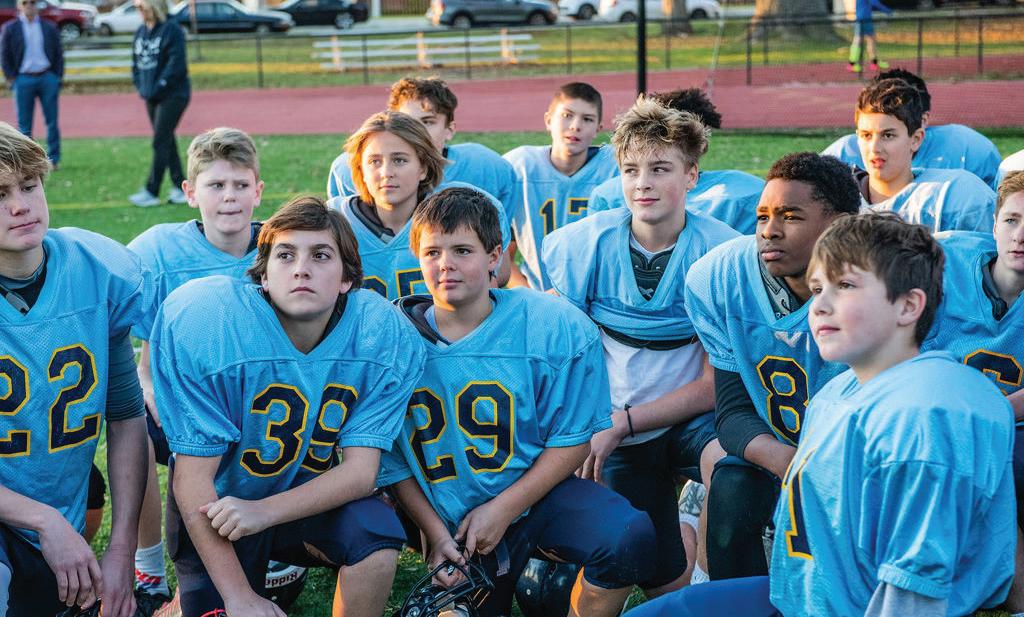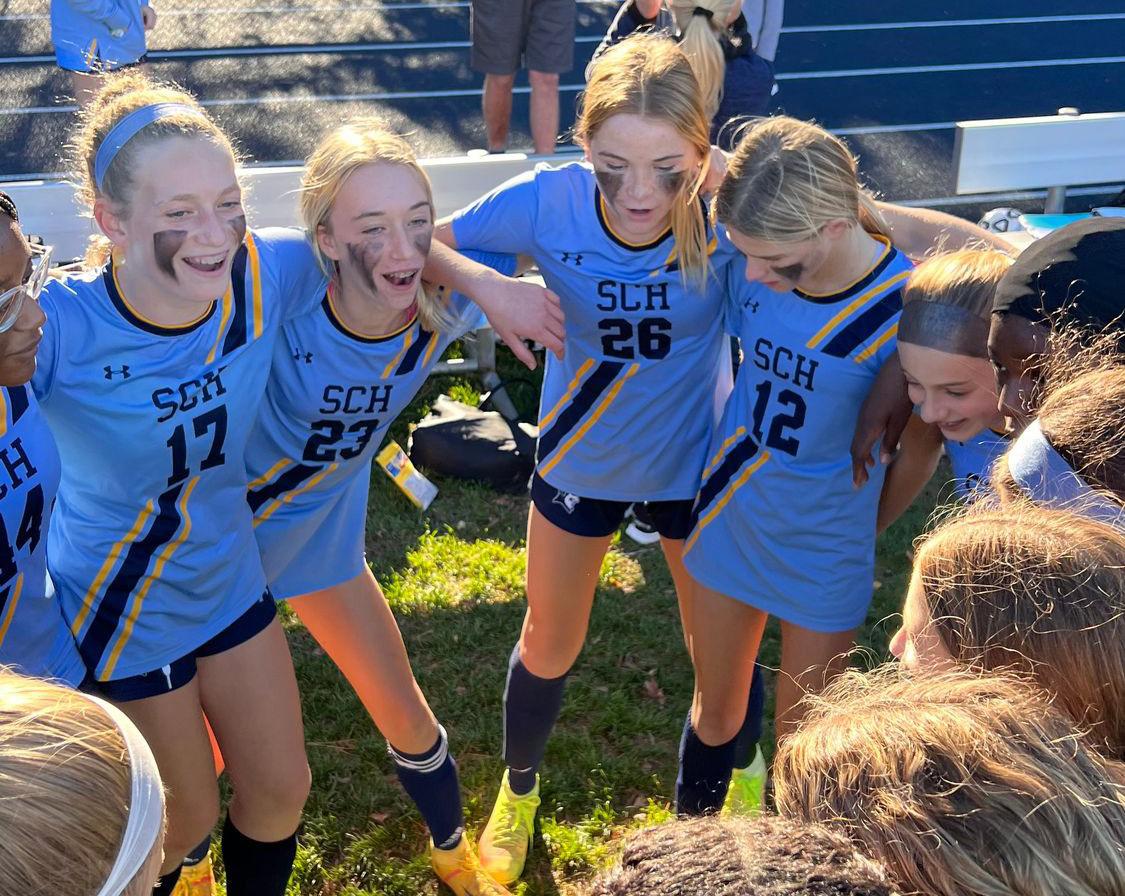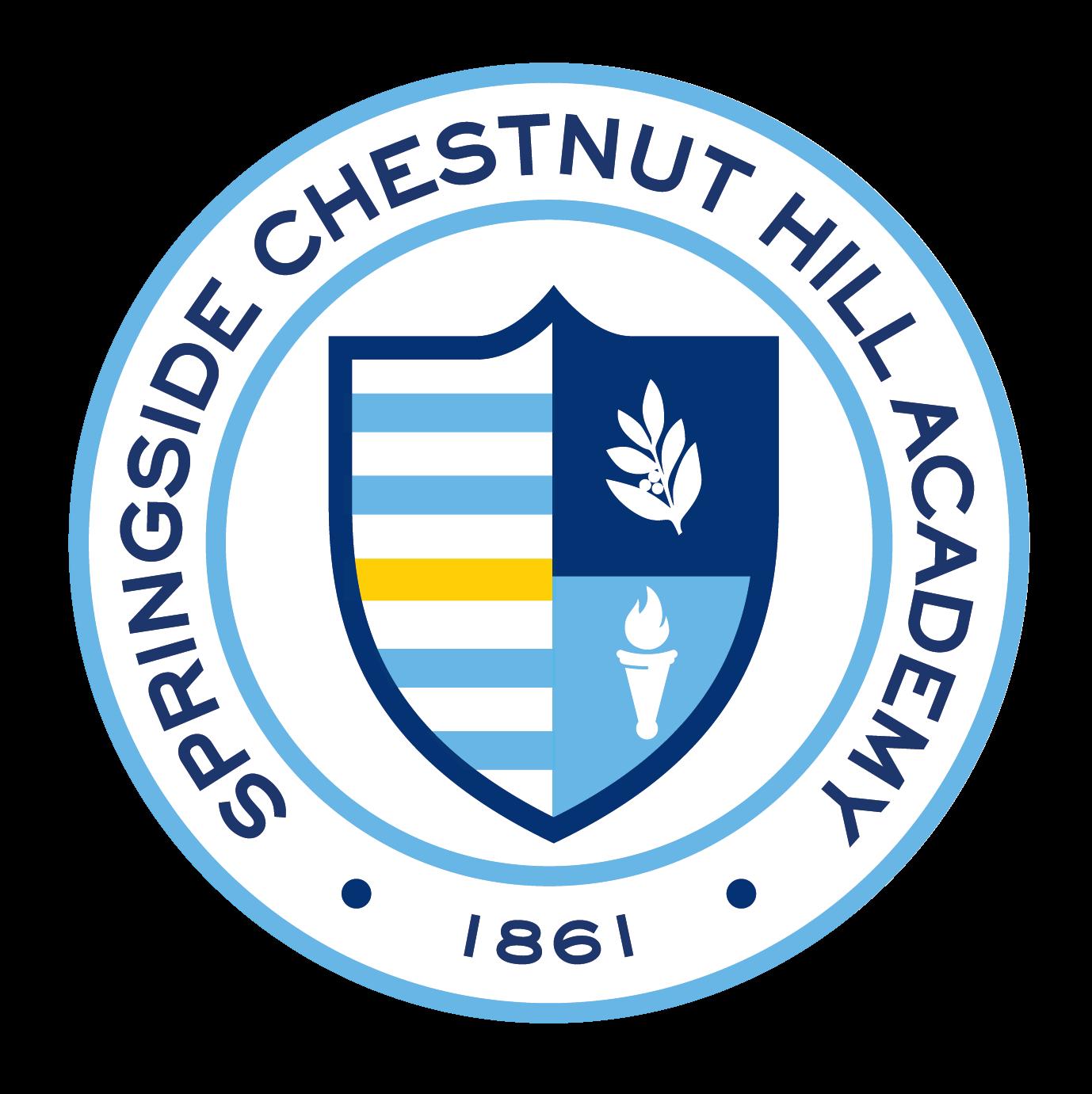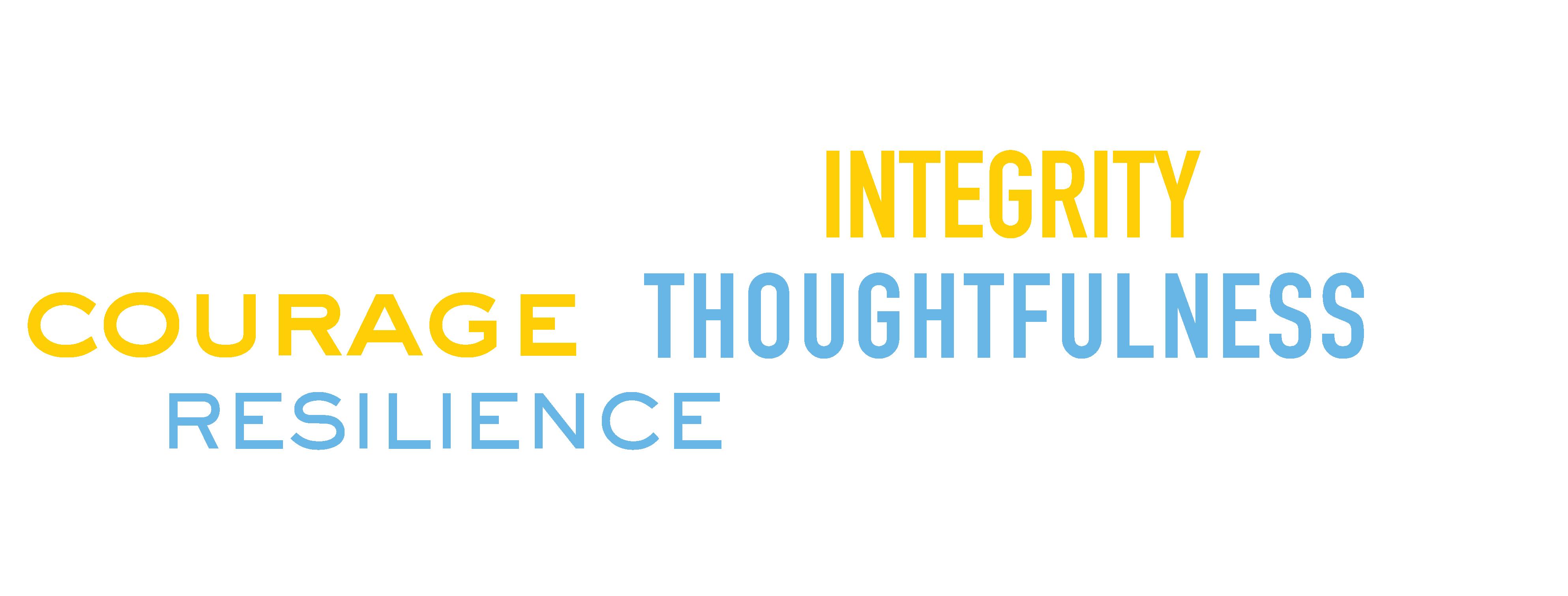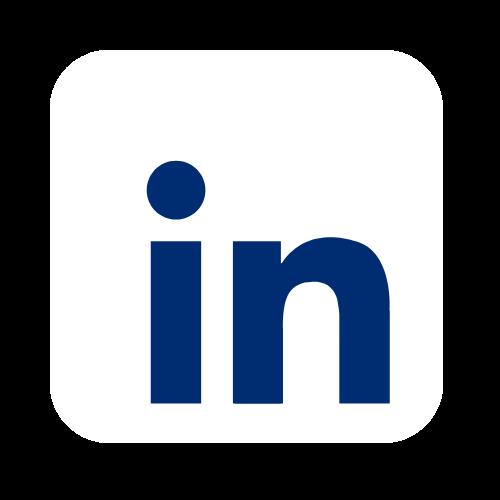

MIDDLE SCHOOL CURRICULUM GUIDE
5th-8th grade
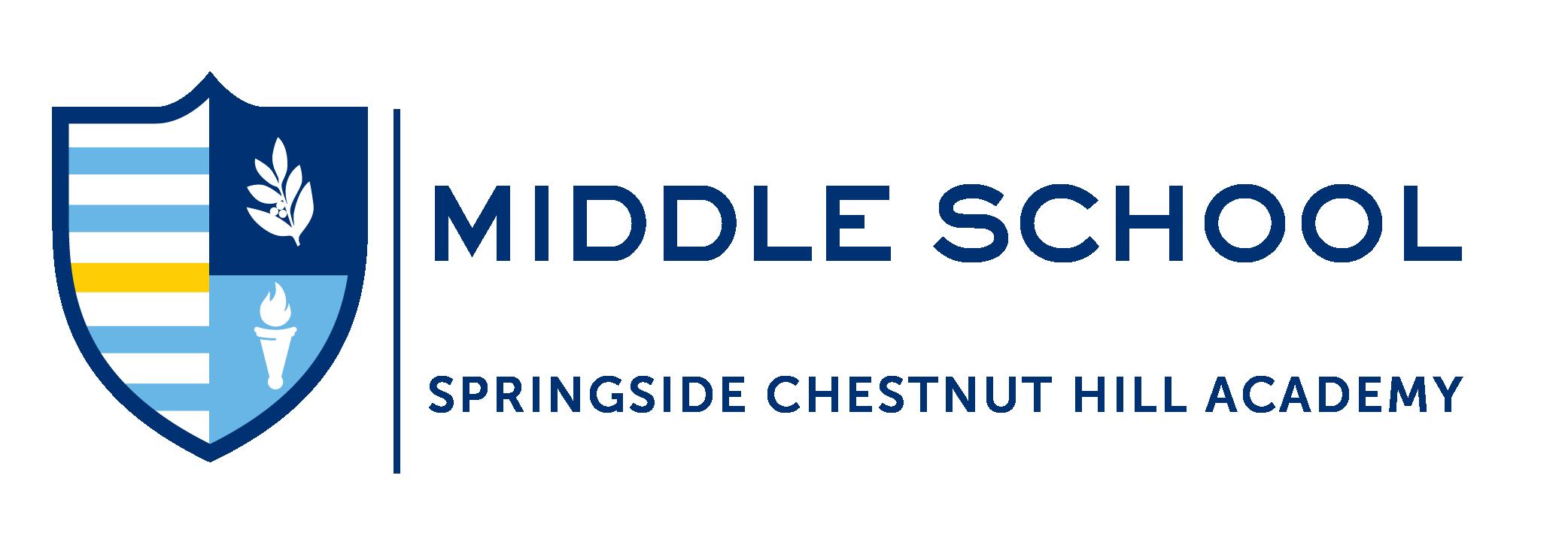
Message from Middle School Head
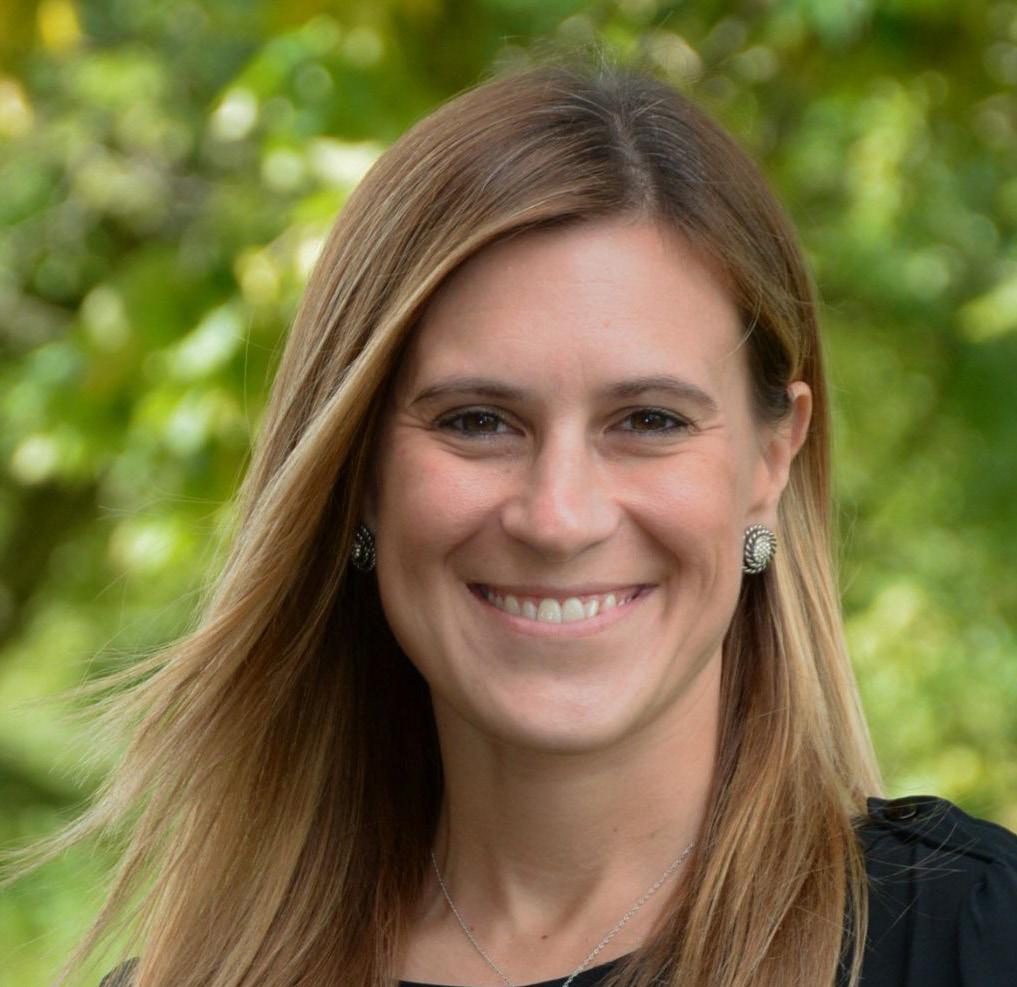
Welcome to the Middle School at Springside Chestnut Hill Academy!
The Middle School years are both transformative and filled with magic. During this critical stage of development, our single-sex classes empower our students to shed gender expectations, develop their unique voices, consider their personal values, question the world around them, and develop a strong sense of self.
Academically, students at SCH learn to think critically, hone their writing skills, and engage in analytical discussions. This is achieved through dynamic and hands-on classes that feature students at the center of their own learning. On any given day, you might find students out in the Wissahickon testing out their scientific hypotheses, in history classrooms experimenting with the ancient mummification process, in the Center for Entrepreneurial Leadership crafting and delivering their own “Ted Talk,” in English classrooms engaging in literary debates, or in labs tackling engineering challenges.
In addition to a vibrant academic experience, relationships are at the heart of each student’s Middle School journey. Our dedicated team of advisors serve as trusted mentors and advocates for their advisees and support all aspects of a student’s development—academic, social, and emotional.
Through both our advisory program and our curriculum, we strive to cultivate empathy in our students and create a strong sense of belonging for each and every person. Ultimately, our 8th graders graduate Middle School ready to seize the myriad academic and enrichment opportunities offered in our coed Upper School.
I encourage you to visit campus and experience the warm community, academic rigor, and undeniable passion that pervade the halls at SCH. As you peek around, you may find yourself wishing that you, too, could return to Middle School!
Meadow Pepino Head of Middle School
Hear more from Meadow Pepino by scanning the QR code!
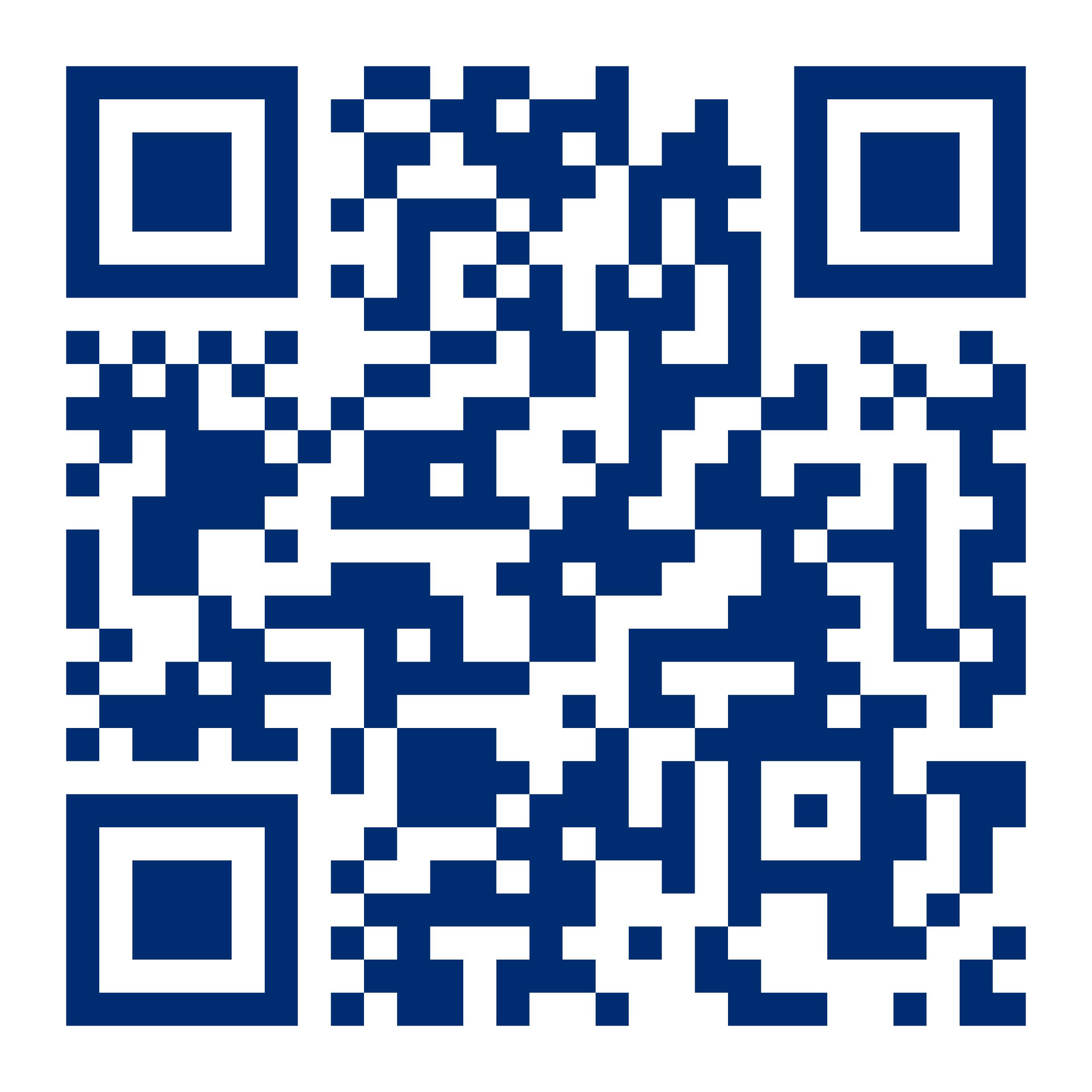
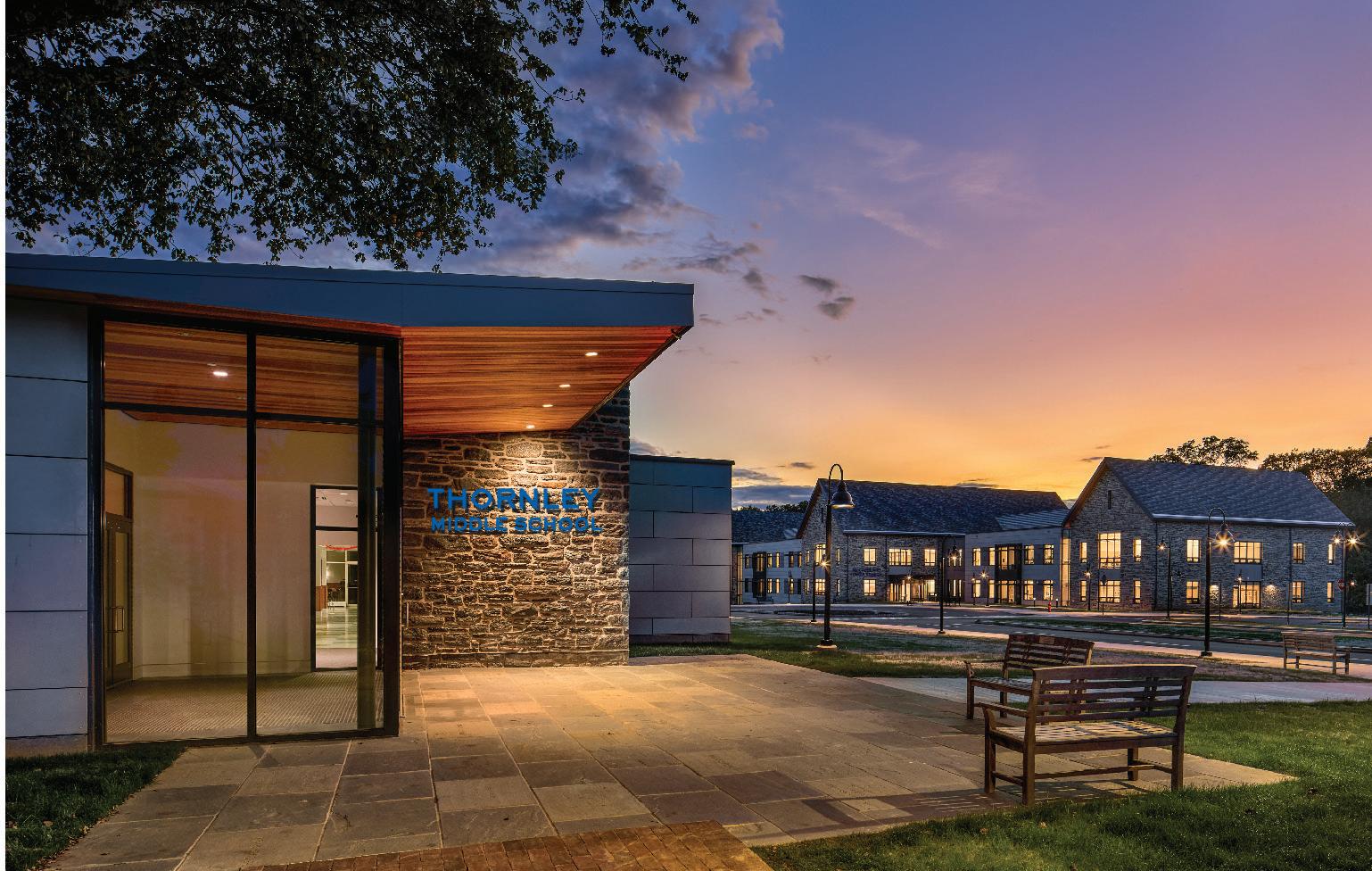
THE FRAMEWORK FOR GROWTH IN MIDDLE SCHOOL: SELF, SCHOOL, AND
SOCIETY
At SCH Academy, Middle School is a time of transformation—a journey in which students deepen their understanding of themselves, their community, and the wider world. Our Self, School, and Society framework supports this journey, with Self representing the importance of introspection and reflection, School encompassing the learning community in which our students connect and collaborate with others, and Society representing the unique urban and natural environments beyond our classroom walls that our students both explore and serve.
Through meaningful and experiential learning, our students develop the thoughtfulness, care for community, empathy, and resilience that is needed to authentically live out SCH’s mission to “effect positive change” in the world.
Self
Our Mission: To inspire unbounded curiosity and independent thought in every one of our students, to nurture their knowledge of themselves, and to expand their full academic and personal potential.
Middle School is ripe with self-discovery. Exploring one’s identity is integral during this developmental stage, and our talented faculty support and care for students as they wrestle with important questions: Who am I? What are my values? How do I learn best? What am I willing to stand up for and against?
This self-exploration is accomplished through our advisory meetings, health and wellness curriculum, and our signature AEIOU program, which advances SCH’s mission to create an inclusive community.
Advisory
Each student is paired with an advisor who serves as a trusted advocate and mentor, guiding academic growth while supporting social and emotional wellbeing. Advisory is more than a check-in; it is a home base where students practice leadership, collaboration, and self-advocacy in a family-style setting. Through trips, service projects, and shared experiences, students discover new passions and develop their unique voice within the Middle School community.
Students meet with their advisory group three times a week at the start of the morning. As part of the Community Time model, they have also expanded advisory opportunities for team-building, one-on-one advisor support, conference reflection, and programming such as AEIOU, studentship skill-building, and advisory chats. This close-knit model continues in the Upper School, providing a consistent foundation for growth and belonging.
AEIOU
AEIOU stands for Awareness, Empathy, Inclusion, Opportunity through differences, and Understanding. As a community, we care deeply about celebrating diversity in all its forms and recognize the importance of considering perspectives other than our own in today’s world. Students engage in regular advisory and classroom lessons that enable them to explore diverse backgrounds, values, identities, and
perspectives in order to build empathy and awareness. Through these thoughtful conversations guided by faculty, our students develop a strong sense of self, explore how they learn best, and exercise their unique voices—the foundation for deeper engagement and authentic learning. The dialogue and personal growth that result are powerful.
Health & Wellness
The Middle School Health & Wellness program is designed to help students become health-literate individuals who can access, understand, and apply knowledge to support their own well-being and that of others. Lessons emphasize the importance of making healthy decisions that lead to a higher quality of life and cover topics such as nutrition, exercise, mindfulness, stress management, human development, puberty, and drug education. In a supportive environment with separate classes for boys and girls, students feel comfortable asking important questions as they learn to make responsible choices and build habits that foster lifelong health.
Grade 5 students participate in Physical Education, a program designed to develop physically literate individuals who move with competence and confidence across a wide variety of activities. They build sport-specific skills, strategy, and problemsolving abilities while learning how physical activity contributes to overall health and well-being. Physical Education also nurtures teamwork, sportsmanship, and resilience; all qualities that prepare students for Middle School athletics in grades 6 to 8 and encourage a lifelong commitment to active, healthy living.
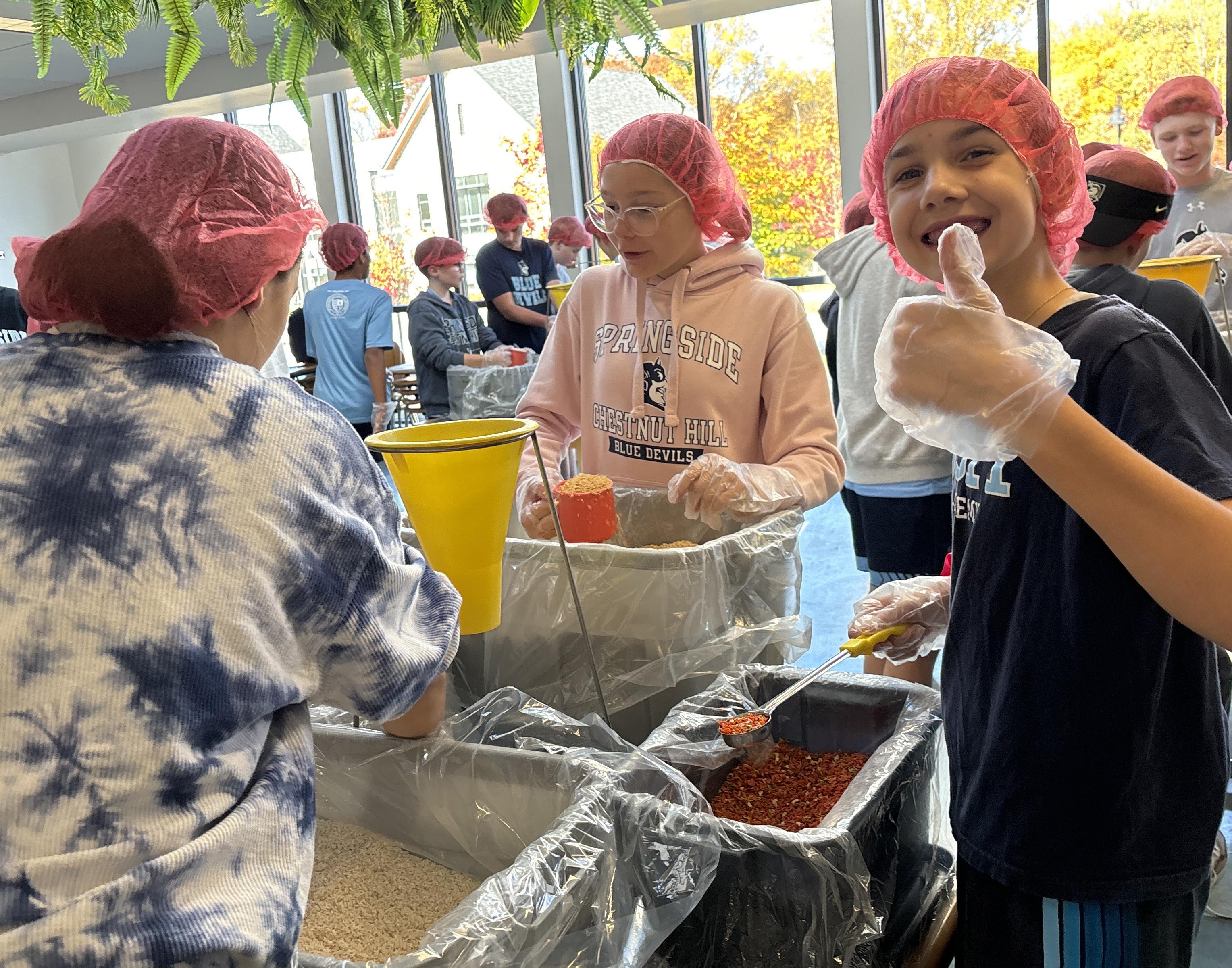
School Community
Our Mission: To cultivate an inclusive community and prepare our students to lead lives characterized by thoughtfulness and integrity.
Throughout the Middle School years, students participate in a range of outdoor and community-based experiences that emphasize collaboration and joy. From orienteering in the Wissahickon to building (and then testing out!) boats at Camp Green Lane to navigating ropes courses at Outward Bound Philadelphia, these activities reinforce teamwork, resilience, leadership, and a sense of belonging. Celebratory spring experiences—such as a student-planned Carnival and field trips to Splashplex and Dorney Park—affirm our commitment to joy and connection.
Our advisory and AEIOU programs are, again, anchors in building a strong school community. Within our community, we care deeply about creating a culture of kindness and respect, and we recognize the critical importance of being able to consider perspectives other than our own. To further support these goals, SCH has built intentional time into the Middle School schedule that allows students to connect, reflect, and grow beyond the traditional classroom experience.
Community Time
Community Time is a dedicated block in the Middle School schedule designed to nurture students’ academic, social, and emotional growth while strengthening their sense of belonging. During this time, students engage in our advisory curriculum through lessons and discussions tailored to the unique developmental needs of their age and gender. Community Time also includes flexible programming that offers support, extension, and enrichment opportunities, with elements of student choice that encourage learners to explore interests, deepen passions, and shape their academic identities. Electives broaden these experiences, giving students the chance to try new activities—often alongside peers from other grades—and discover skills, talents, and communities they might not have encountered otherwise.
Society
Our Mission: To nurture students’ knowledge of the world and to empower them to effect positive change.
Our service and curricular trips extend learning beyond the classroom, emphasizing civic responsibility and global citizenship. In service to our larger society, SCH Middle Schoolers partner with the Philadelphia Ronald McDonald House to create “Fun Kits” to brighten the days of children receiving ongoing medical treatment, travel to Riverbend Environmental Education Center to be stewards of the earth by planting trees and removing invasive vines, host meal-packaging events with Rise Against Hunger, and volunteer at Cradles to Crayons Philadelphia, an organization whose sole purpose is to make life better for children in need.
Students also explore the rich resources of Philadelphia and beyond—including the National Constitution Center, Penn Museum of Archaeology and Anthropology, and a culminating trip to Washington, D.C.
Our mission calls us to nurture students in “a unique educational environment that extends well beyond campus.” These thoughtfully scaffolded experiences are essential to that promise—inspiring students to know themselves, connect with others, and step into the world with confidence and purpose.
LEARNING THAT GOES BEYOND THE CLASSROOM
From the banks of the Wissahickon to the heart of Washington, D.C., SCH’s Middle School trips are as bold and dynamic as our students. Every grade embarks on a carefully curated sequence of adventures that spark curiosity, build character, and foster connection.
What Makes Our Trips Special?
• Adventure and Growth: Orienteering, ropes courses, and boat-building push students to work together and test their limits.
• Service with Purpose: Packing meals, planting trees, and volunteering for local nonprofits give students meaningful ways to make a difference.
• Real-World Learning: Whether exploring the Penn Museum of Archaeology and Anthropology, the National Constitution Center, or the Woodmere Art Museum, our trips bring curriculum to life through local, interdisciplinary experiences.
• Joy, Always: End-of-year celebrations at places like Dorney Park and Splashplex Waterpark give students time to unwind and celebrate their hard work.
Common Highlights by Grade:
• 5th-Grade: Orienteering, College Settlement Camp, Penn Museum of Archaeology and Anthropology, Weitzman National Museum of American Jewish History, and Splashplex Waterpark
• 6th-Grade: Riverbend Environmental Education Center (Amazing Race and service), Philadelphia Museum of Art, Philadelphia Zoo, Splashplex Waterpark
• 7th-Grade: Rise Against Hunger, National Constitution Center, Eastern State Penitentiary, Woodmere Art Museum, and Dorney Park
• 8th-Grade: Outward Bound, Cradles to Crayons, world language trips (Taller Puertorriqueño, Chinatown, Grounds for Sculpture, etc.), Dorney Park, and a capstone overnight trip to Washington, D.C.
At SCH, learning doesn’t stop at the classroom door. Our Middle School trips and experiences are more than memorable—they are transformational.
And ultimately, our Self, School, and Society framework becomes the lens through which students learn to understand and navigate the world: starting with introspection, deepening relationships within our community, and, finally, engaging thoughtfully with society.
CURRICULUM GUIDE
ENGLISH
The ability to read critically, interpret figures of speech and characters’ motivations, analyze narrative and poetic structures, speak with conviction, listen with empathy, and write clearly and confidently are not only crucial to literature studies but also invaluable skills for understanding this ever-changing global community. Our English program is skill-based but also fosters a lifelong love of reading whose foundation is an investigative, curious spirit and a desire at every turn to respond with the student’s observations, beliefs, and analysis.
The Middle School English program reinforces and builds upon our students’ reading fluency and comprehension, develops their interpretive reading and analytical writing abilities, and expands their grammar and syntax mastery. The books they read are chosen for their literary quality, diversity of voices, and appeal to Middle School students. Common books between the boys’ and girls’ curriculum include classics like A Midsummer Night’s Dream, Number the Stars, and The Giver. More contemporary tales offer students windows into other worlds and experiences, including texts such as A Long Walk to Water and I’ll Give You the Sun in the boys’ curriculum and Incantation and Brown Girl Dreaming in the girls’ curriculum. Writing assignments embrace expository, poetic, narrative, and analytic writing forms. Our students leave Middle School as analytical thinkers, critical readers, and dynamic writers with the confidence and toolbox to help them thrive in Upper School English.
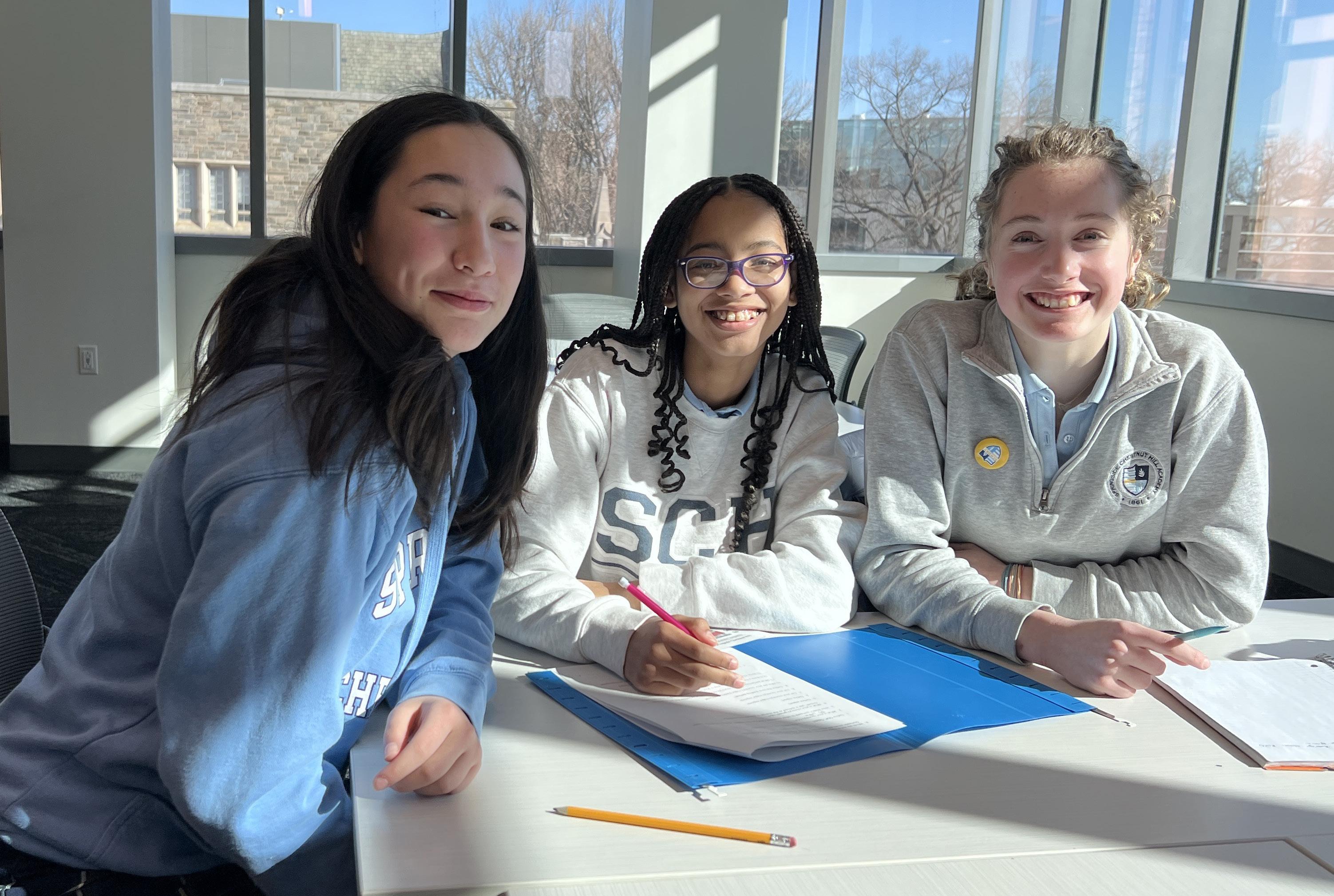
Grade 5
In 5th-grade English, students across both divisions learn to become more effective readers, writers, and speakers, and develop the ability to see things from different points of view. Because of the unique skills and perspectives that all students bring to the classroom, students learn together how to enjoy literature and see how books connect to their own lives. Students ask, “What can I learn from reading this book?” and “How can we best share our ideas with others?” Grammar and vocabulary study are integral course components.
Grade 6
In 6th-grade English, students pursue the goals of thinking, writing, and speaking effectively and critically; reading with greater competency and enjoyment; becoming conversant with the terminology of literary analysis; understanding the different qualities of the literary genres; incorporating good grammar and a varied vocabulary into their writing and speech; and taking intellectual risks. Essential questions pursued during the year include “Why do we read and write literature?” “What makes a work of literature ‘great’?” and “What makes a place feel like home?”
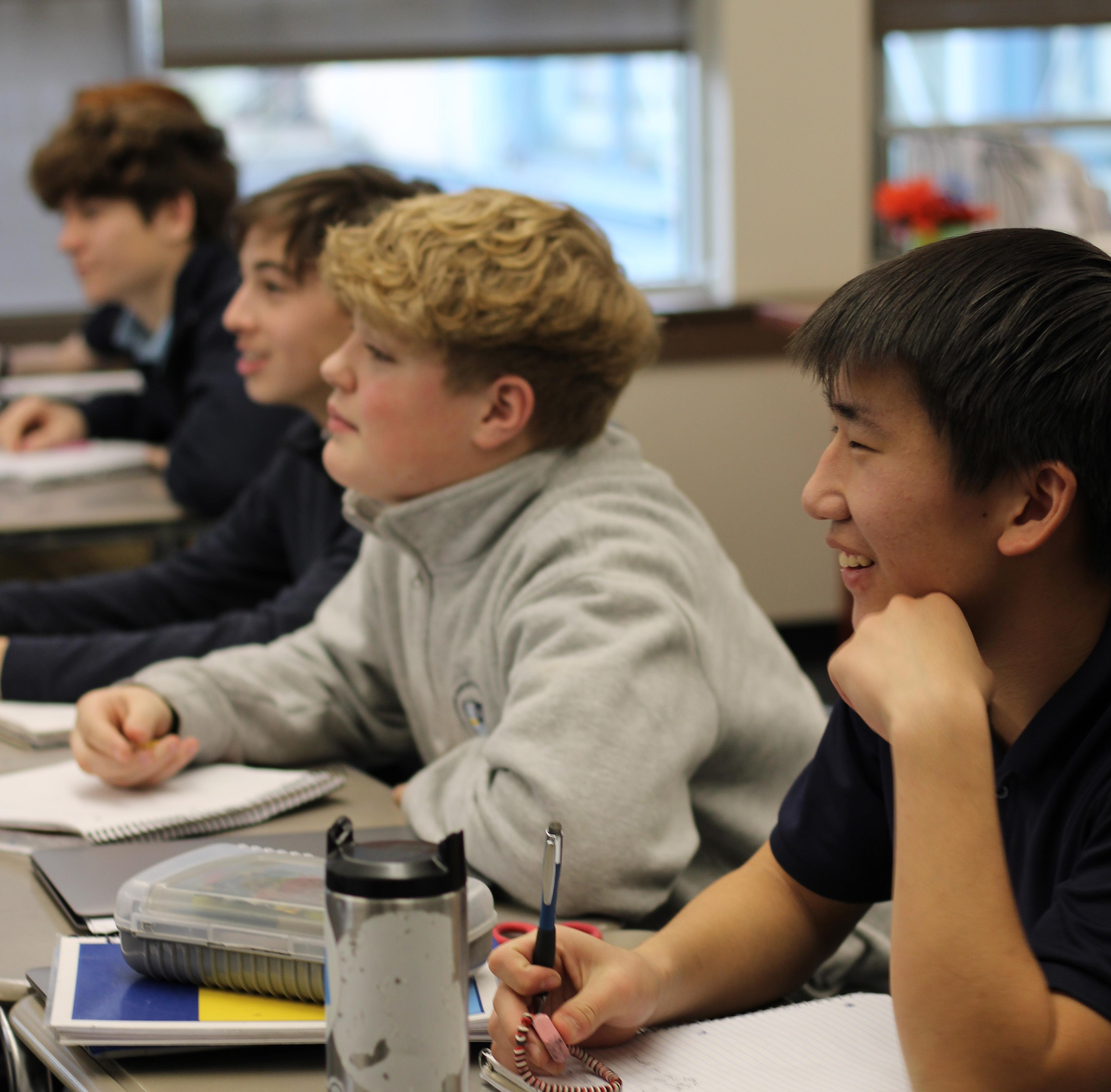
Grade 7
In 7th-grade English, students continue to pursue the goals of their previous year but with greater depth and rigor. In addition to the questions of why we read and write literature and how and why authors create their stories, students will ask, “Who am I, and how do I show myself to the world?” Specifically, this class focuses on the various aspects that make up a person’s identity and how that identity affects our interactions with the world around us. Through historical and contemporary texts, students will trace the evolution of characters’ identities and how authors use language to communicate feelings and promote societal change.
Grade 8
In 8th grade, students consider the themes of dreaming and the power of artistic expression in constructing selfidentity. The characters encountered in this course are compelled by powerful social forces and must make bold choices about who they want to be in the world. Examining a wide range of literary forms—including memoirs, novels, lyrical poetry, short stories, and drama—students critically interrogate the ways authors explore class, race, gender, sexuality, family make-up, and other aspects of identity. They also get a chance to unpack these ideas creatively as writers in several literary forms. Throughout the year, much attention is paid to the historical context of each piece, how an author’s perspective is revealed by their use of language, and how divergent experiences conveyed through art can reveal a shared humanity that connects to our lives today.
HISTORY
In today’s dynamic global environment, a strong knowledge of history and the ability to think critically are essential parts of how and what we learn. Middle School students study history in inquiry-driven classrooms that promote experiential learning and develop historical empathy. Understanding the perspective of historical figures and their diverse experiences allows students to reflect upon their own lives to understand more fully the world and cultures that shape them.
In Middle School, the history curriculum is tailored to the passion, curiosity, imagination, and energy of our students. In 5th and 6th grades, students examine the geography and history of the ancient world, exploring themes with contemporary relevance. In 7th and 8th grades, they participate in a two-year study of American history using the resources of Philadelphia to engage in real-life, hands-on learning. Students deepen their ability to analyze and create a wide variety of traditional and digital technologies, write in many formats, and present and speak publicly.
Our curriculum emphasizes geography, reading, writing, and analysis. Studying history is not just memorizing information about the past; it is a way of thinking and learning. Students will apply and demonstrate knowledge and understanding through a variety of activities and assessments.
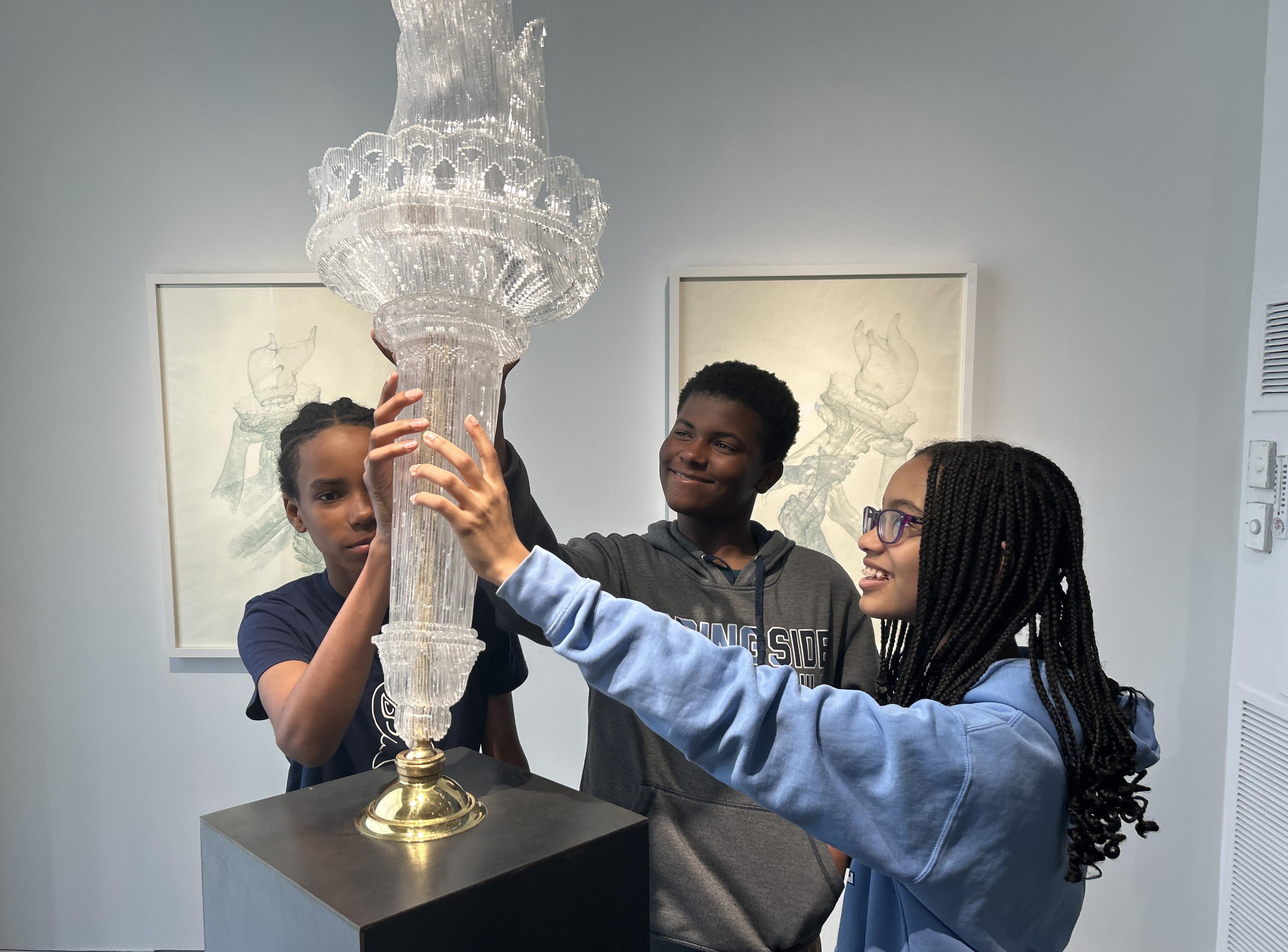
Grade 5
History in 5th grade begins with the dawn of human civilization. We travel through time and place to explore a wide variety of communities, and in doing so, students learn to see their own lives from a new perspective. Students in this class create, critique, and collaborate, as well as strengthen their reading, writing, study, and communication skills. We bring in a range of technologies to showcase what has been accomplished. This course kicks off with a study of geography, historical timelines, and prehistory. Then we explore the government, economy, religion, military, and society (GERMS) of Mesopotamia, ancient Egypt, ancient India, and ancient China. Analytical essay writing prompts and discussions of current events in these modern countries and cultures are interwoven into the units. Some overarching themes are developing historical empathy, perspective-taking, and open-mindedness.
Grade 6
In 6th grade, students continue developing their analytical writing, communication, critical reading, notetaking, and study skills while studying a variety of important civilizations throughout time. Using a blend of primary and secondary sources, students learn to inquire into, organize, and explain events that have happened. In the first unit on ancient Greece, we explore their beliefs, government, and lasting impacts on philosophy and culture. This is followed by a dive into ancient Rome, where students learn about the Empire’s leaders, as well as research Roman advances in engineering and science. The third unit is on Islam, providing the opportunity to learn about its rich religious history and scientific contributions, as well as study the architecture of famous mosques throughout the world. This unit is followed by a study of West Africa, exploring the fascinating empires of Ghana, Mali, and Songhai. The next unit
delves into the Middle Ages, the Italian Renaissance, the Scientific Revolution, and the Age of Exploration. Finally, students explore Mesoamerica, setting them up for the study of Native Americans at the beginning of 7th-grade.
Grade 7
This class covers American history from the First Peoples through the Civil War. Students explore the social, political, and economic factors that shaped the foundations of the U.S., with a particular focus on the intersection of race, gender, and class. Students will consider multiple narratives and diverse perspectives through a variety of primary and secondary source texts, documentaries, and images. We’ll also connect these stories to the present to gain a deeper understanding of our country today.
Grade 8
This class looks at American history from 1865 to the present through multiple narratives. Just as varied as the voices we will study are the ways we study them. We will explore the ways people have experienced and contributed to our country. Race, gender, and class will be three of our lenses as we examine how power and injustice have shaped the U.S. We’ll also connect these stories to the present to better understand our country today. Students will consider multiple narratives and diverse perspectives through a variety of primary and secondary source texts, documentaries, and images.
WORLD LANGUAGES
The language program is shaped by two important beliefs: the first is that it is essential for our students, in an ever more interconnected world, to develop an awareness of and appreciation for cultures other than their own. The second is that they can accomplish this goal more thoroughly and meaningfully by competently communicating in their target language.
Grade 5
In 5th grade, students take a unique course called Language Explorers, which provides them with exposure to all three of our world languages: Latin, French, and Spanish. This positions students to then select the language they would like to continue in 6th grade.
Grades 6—8
In 6th grade, we offer French, Latin, or Spanish. Students entering the Middle School in 7th or 8th grade who do not have prior language exposure will be placed into Introduction to Language and will then have the opportunity to pursue a specific language in 9th grade. New 7th and 8th-grade students who already have language exposure in French, Spanish, or Latin have the opportunity to be placed into the respective language.
NOTE: Language classes will run depending upon sufficient enrollment and may be coed.
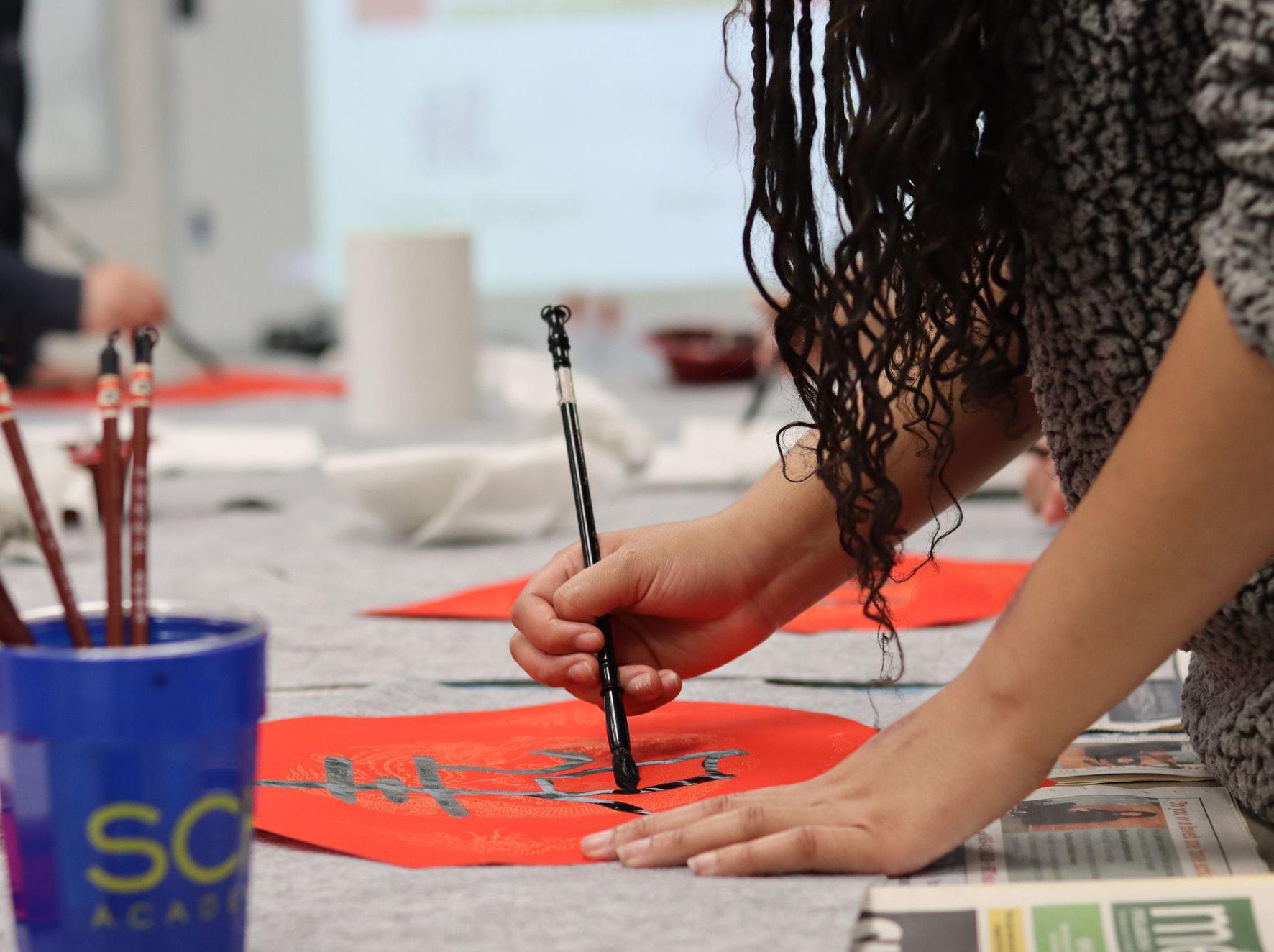
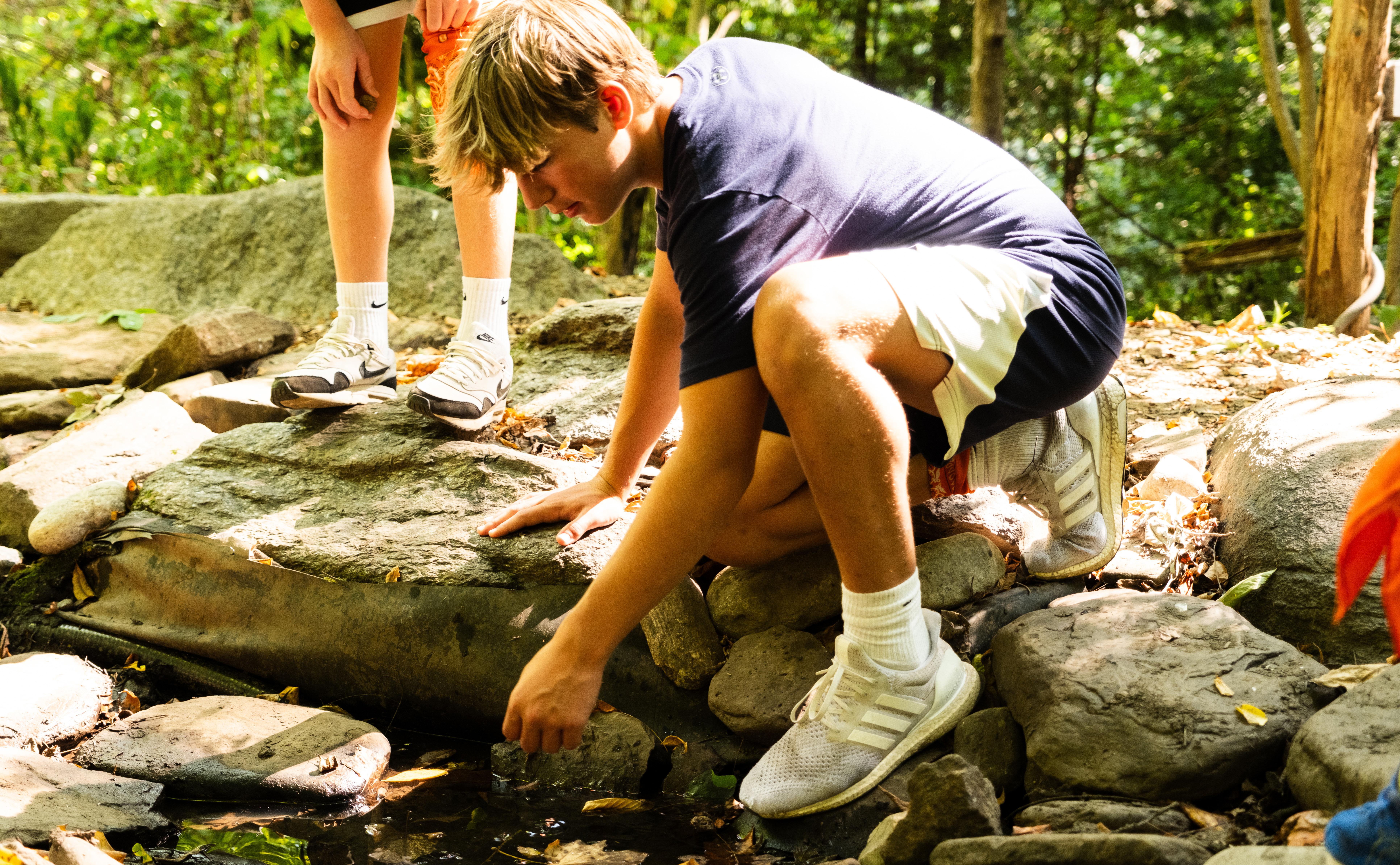
SCIENCE
The science curriculum offers students in every grade challenging and exciting learning experiences that help them develop the skills of scientific inquiry and an understanding of the laws, systems, and structures that define our natural world. Classes provide students with opportunities to use the most up-to-date equipment and technologies as they ask questions, design experiments, explore, collaborate, and become efficient and effective problem solvers.
Our interdisciplinary curriculum integrates engineering principles in meaningful and relevant ways and asks students to quantify their work using appropriate mathematical and statistical tools and use the arts and new media to model their work or creatively and richly display what they have synthesized.
Teachers are guided by the Next Generation Science Standards, PA Science Standards, the National Science Teachers’ Association, and local curricular materials. In addition, all divisions make extensive use of the surrounding Wissahickon ecosystem, as well as the school’s work in sustainability, as part of our dynamic, real-world curriculum.
Our project-based approach to learning challenges students to design their own investigations by forming hypotheses, investigating in the lab or field, quantifying and analyzing data, and drawing conclusions. These projects involve them in meaningful, open-ended, inquiry-based problem solving, from designing and constructing solarpowered cars to engineering earthquake-resistant towers. In 7th and 8th grades, students have an opportunity to gain greater exposure for their research projects by entering outside competitions such as the Christopher Columbus Awards and the Junior Solar Sprint at the Franklin Institute. Through these experiences, they strengthen their scientific skills and begin to think of themselves as scientists and engineers.
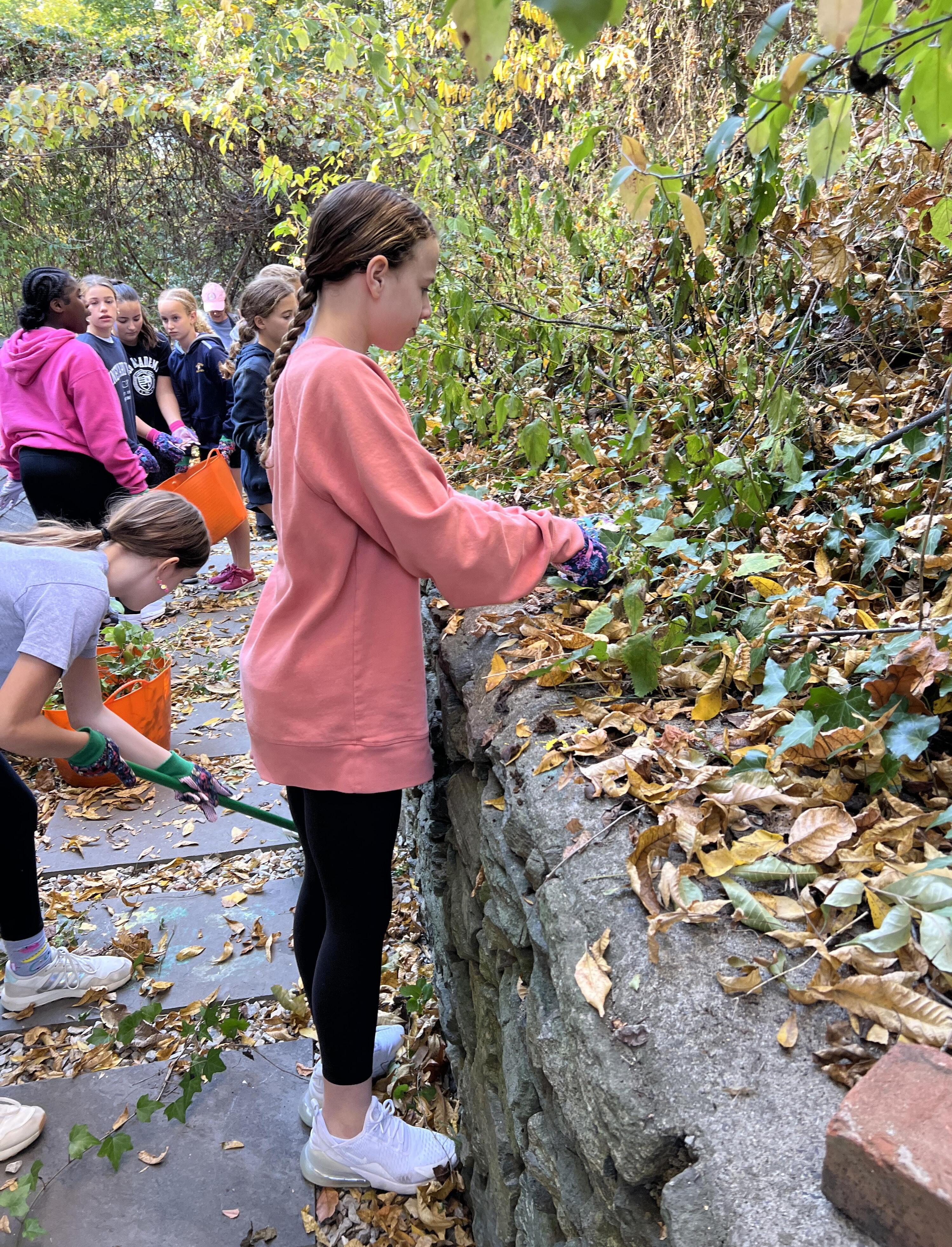
Grade 5: General Science
In 5th-grade science, students explore the relationships between the basic sciences of chemistry, physics, and biology. During the ecology unit, students investigate the world around them and improve their problemsolving abilities. One highlight includes conducting fieldwork in the Wissahickon to study seasonal changes, culminating in a behavioral study of insects where they learn the process of experimental design as part of the scientific method. During their water chemistry unit, students conduct lab investigations that explore pH and solubility, and explore drinking water and wastewater treatment processes. During their introduction to Newtonian physics, students conduct investigations to learn about Newton’s second law. They use their knowledge of physics principles to design and build miniature golf course holes that they try out with Lower School students. The class focuses not only on science content and skills, but also on helping with overall studentship skills and science reading literacy.
Grade 6: Earth Science
In 6th-grade Earth sciences, students learn the basic concepts of astronomy, meteorology, oceanography, and geology through hands-on activities, experiments, demonstrations, and individual and class projects. During our astronomy unit, students design and build a model space probe capable of extraterrestrial exploration. During our meteorology unit, students use weather data to forecast each day’s weather. Geology topics include minerals and the rock cycle, earthquakes (including the design and construction of earthquake-resistant towers), and volcanoes (including a Google Earth-based analysis of the “ring of fire”). Hikes around the school and in the surrounding Wissahickon enhance students’ knowledge of the area’s rich geological history. Other highlights of the course include an evening star party presented by Astronomy to Go.
Grade 7: Life Science
In this course, 7th graders study the characteristics that unify living things. They begin by investigating cells, the basic units of life, and explore the interconnectedness and uniqueness of organisms by looking at adaptations, how species have changed over time, and how living things are influenced by the environment. They also investigate genes, chromosomes, and DNA, and they use Punnett squares to investigate genetic inheritance. They extract DNA and use gel electrophoresis to separate and analyze DNA fragments. With this foundation in cell biology, genetics, and evolution, the 7th graders go on to study human anatomy and physiology. Several biophysics units highlight the interdisciplinary nature of science. For example, when studying the eye, students conduct optics investigations to understand the physics of light waves. Similarly, the unit on the ear and hearing integrates labs involving the physics of sound waves. They also take part in an
original team experimental research project, where students address a local concern related to the immune system, health, and disease transmission, then design and investigate a solution to the problem and present their work to their peers.
Grade 8: Physical Science
This course provides students with a basic understanding of the properties of matter, the various types of energy and their uses, and the effects of energy use on their own lives and on the environment. Students learn to explain and quantify everyday phenomena in terms of the scientific principles learned in class. They design their own experiments to solve a variety of problems, many of which are openended, allowing individual creativity to shape their solutions. When studying heat, the 8th graders design and build model energy-efficient houses. Other topics covered include atomic theory, home heating, and electronic circuit design. Students also participate in an extended interdisciplinary unit involving solar car design and construction that concludes with participation in the SCH Solar Sprint competition. At the end of the year, students learn about alternative energy sources, including researching and designing infographics related to the “story of energy use.”
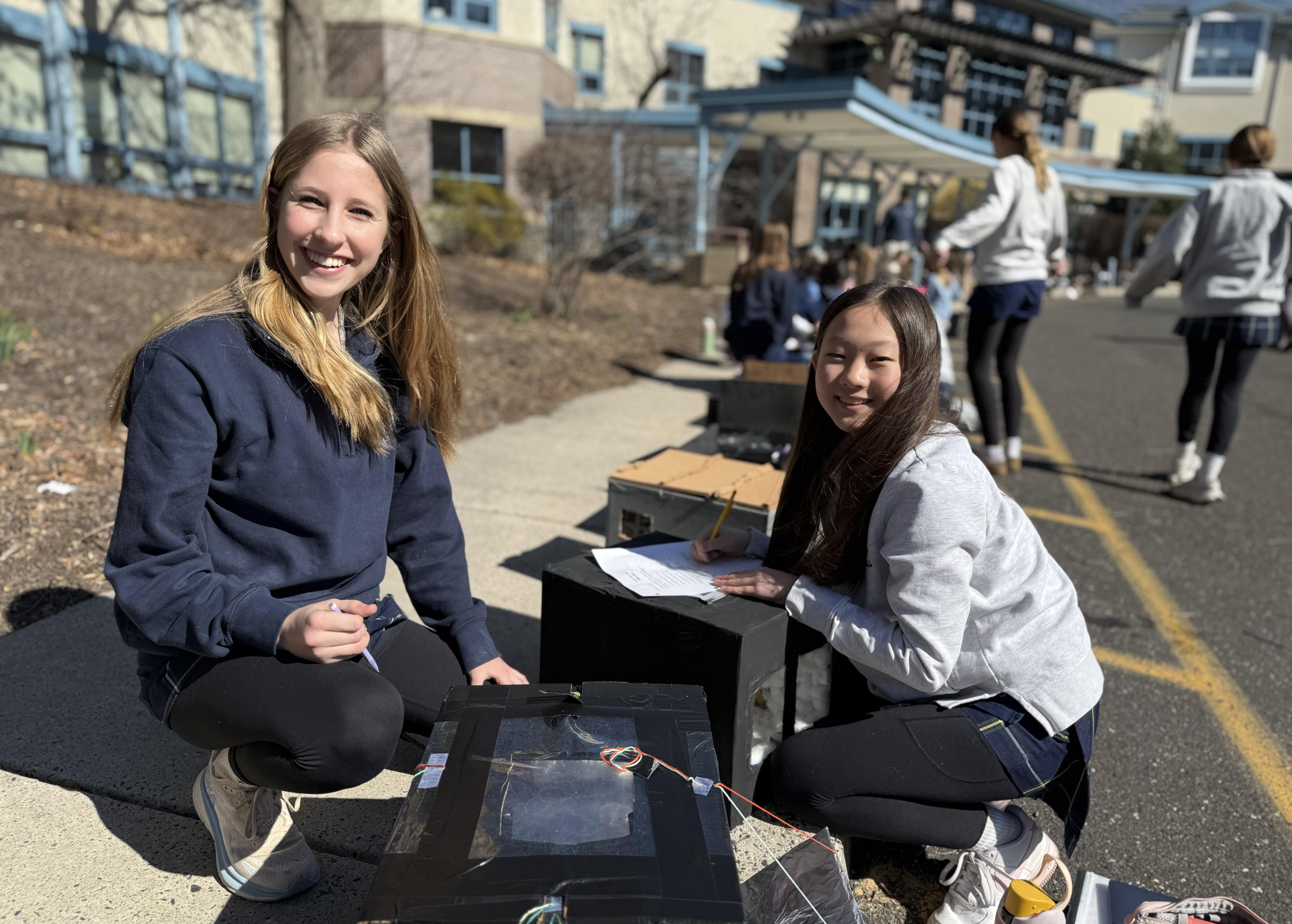
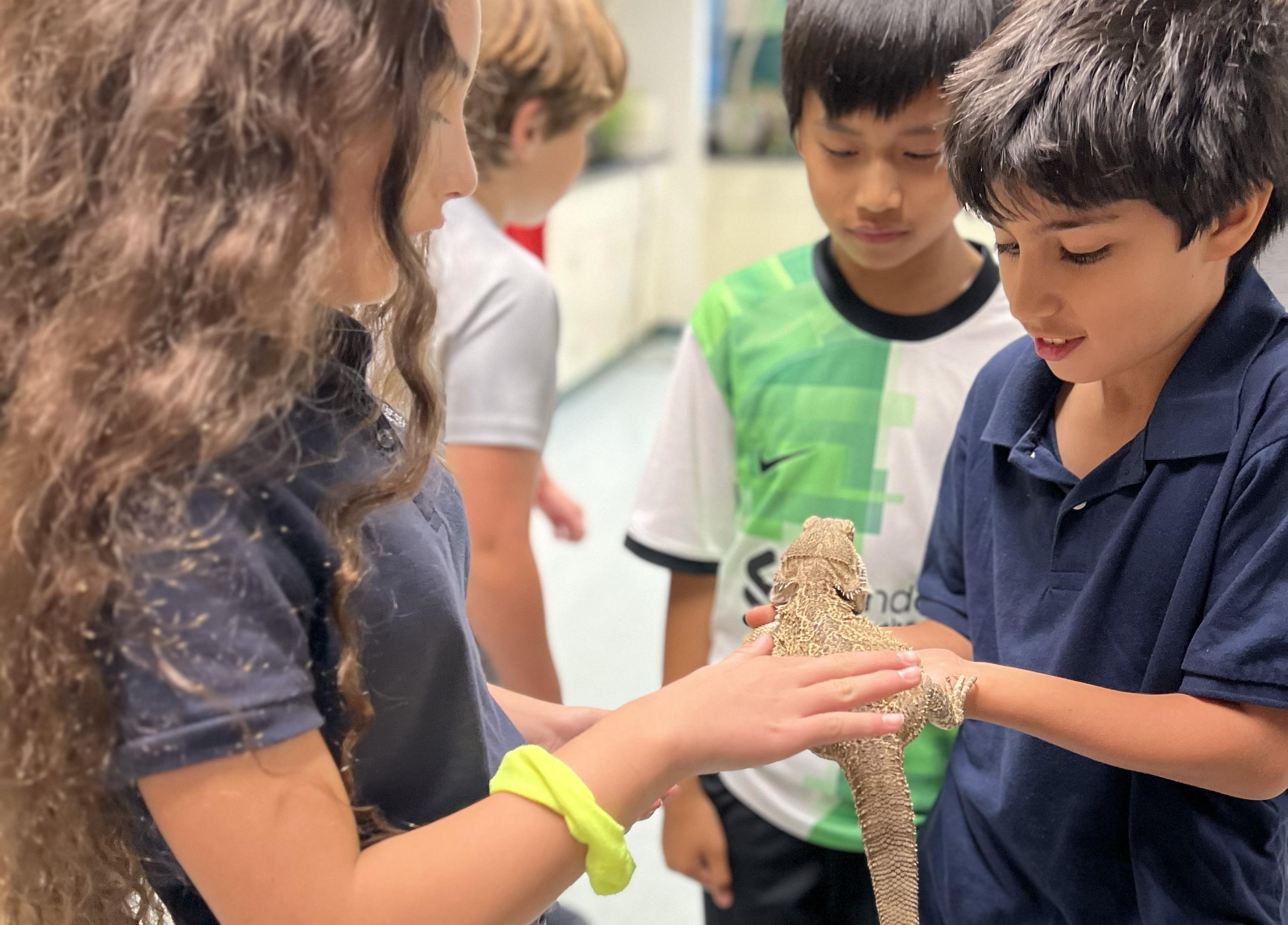
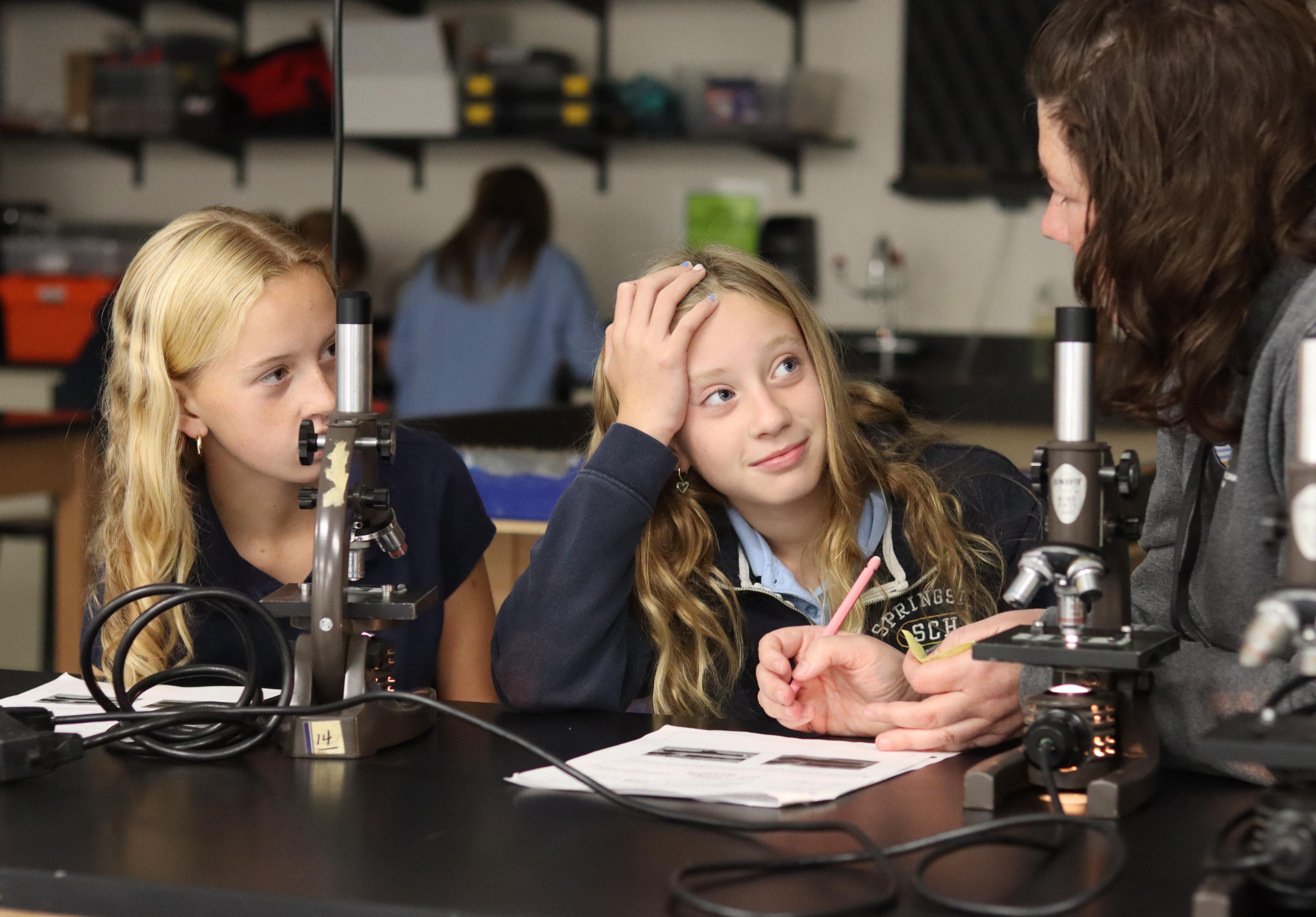
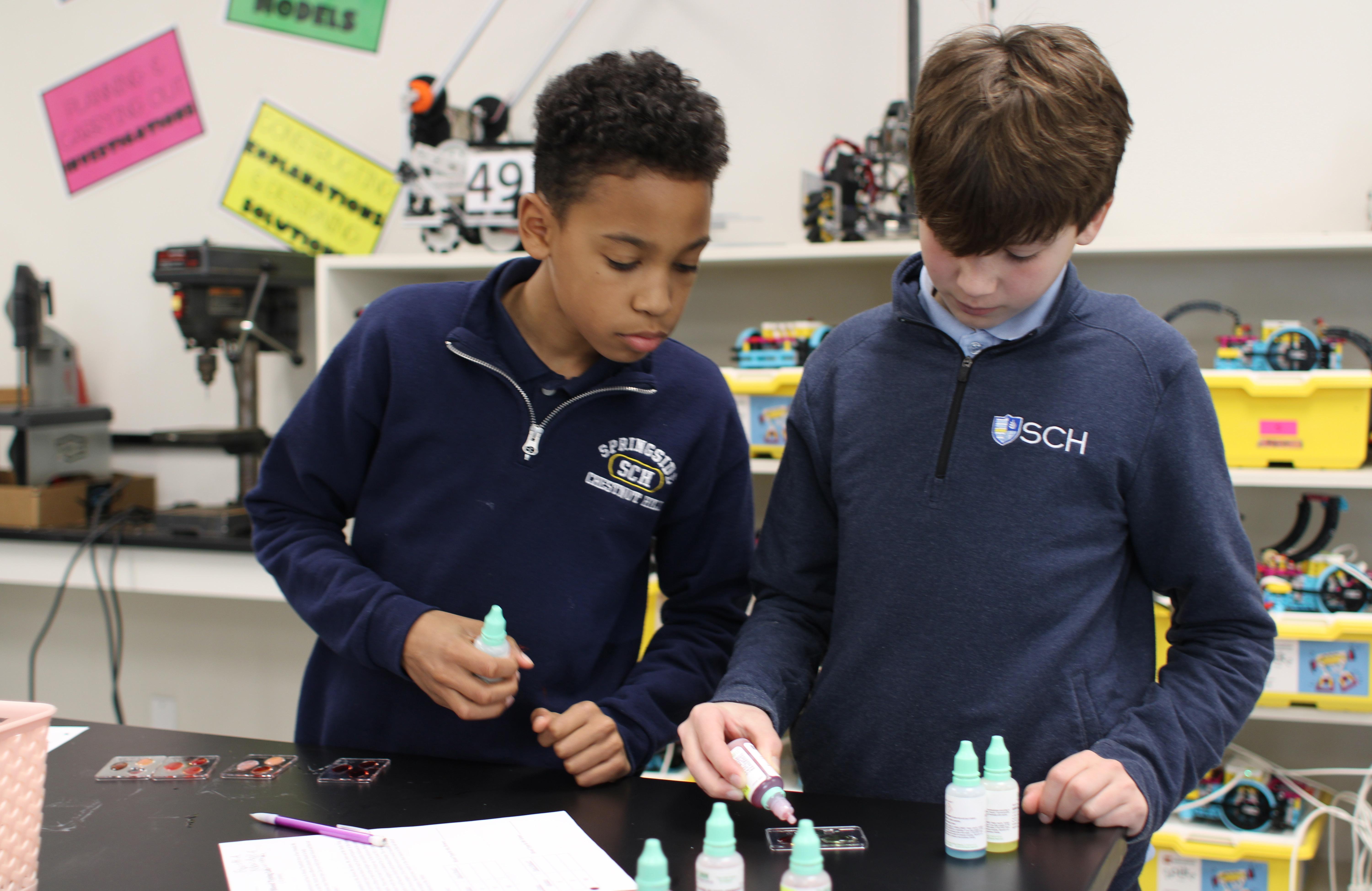
MATHEMATICS
The mathematics program at SCH aims to develop students’ pattern recognition, problem-solving, modeling, and application skills across a variety of real-world contexts and mathematical topics. This is accomplished throughout the program’s curriculum series, Big Ideas Math: Modeling Real Life. The activities in this curriculum consistently ask students to explore, practice, and apply mathematical content. In our classrooms, we do this via a “student-first” approach. Students are initially engaged with new mathematical problems to reason with and make sense of, in collaboration with their peers, by leveraging their prior mathematical knowledge. The curriculum is chock-full of word problems! We want our students to 1) be willing and eager to tackle a new problem, regardless of the problem’s challenge or ease, 2) develop a deeper understanding of a mathematical idea in various ways, and 3) see the usefulness and application value of mathematics.
Middle School math emphasizes process over results, as it exposes students to numerical, fractional, and algebraic thinking. Deep understanding and flexible use of the key topics of place value, fraction operations, proportional reasoning, and slope have been shown to be strong predictors of future success in mathematical ability. Our program develops this understanding and associated skills with these topics in all four grade levels.
Recognizing that students develop mathematical abilities at different rates and with different needs for support and challenge, it is in grades 7 and 8 that we group students by performance. Each year, there is one advanced grouping amongst boys and girls that delves deeper into content while asking those students to engage with problem-solving opportunities more independently.
We want to engage students with the messiness and complexity of mathematics in the real world. To this end, we integrate a variety of activities and assessments, such as STEAM tasks, journaling, investigations, and projects. Middle School students gain confidence and expertise in tackling multi-step problems and translating mathematics into the real world.
Grade 5
Our 5th-grade math is all about strengthening and solidifying students’ number sense and problem-solving skills. Students engage with and grow their understanding of whole numbers, fractions, decimals, place value, and the operations that relate them. We push students to reach procedural fluency while strengthening their conceptual understanding of these numbers and relationships via visual representations. We emphasize and strengthen students’ use of estimation as a way to check for reasonableness in their answers, a key component of our new curriculum, Big Ideas Math. Additionally, we grow students’ adaptive reasoning and strategic competence abilities by asking them to analyze, strategize, and solve real-world problems and situations involving these kinds of numbers, operations, and relationships.
Grade 6
Our 6th-grade math course builds upon the number sense and relationships solidified during 5th grade. We take what students can do with whole numbers, fractions, decimals, and percents, and begin to include new kinds of numbers and operations such as coordinate graphing, ratios, rates, proportions, exponents, divisibility, factors, and multiples. We also empower students to achieve fluency in simplifying larger, longer, and more complex numerical expressions, and we encourage them to apply their
current math knowledge within the realm of descriptive statistics, basic probability, variables, and unknown quantities. We ask students to work with data sets of non-whole numbers, to compute percentages and probabilities for realworld decision-making, and to apply proportional reasoning to convert units of measurement and to solve practice challenges. Overarching learned skills are mathematical communication, organizing mathematical work, making a problemsolving plan, and transferring their skills to non-routine problems.
Grade 7
In 7th grade, students begin to use their knowledge of operational relationships to work with known and unknown quantities. They do so by writing and solving simple equations and inequalities, as well as examining real-world applications and problem-solving. Students are asked to analyze, model, and solve problems such as percent change and proportional reasoning via algebraic expressions and solve multistep equations. Students are introduced to linear functions and the ability to graph within a coordinate plane through an investigation of slope and rates of change.

Grade 8
The goals for students in 8th-grade math are to: 1) complete a typical Algebra I course, and 2) prepare for Upper School Geometry and Algebra II. We start the year with a review of simplifying algebraic expressions and solving linear equations, and then kick off 8th-grade Algebra with a study of functions. This study of functions leads us to an in-depth unit of graphing and writing linear functions, which then extends to the graphing of linear inequalities and solving systems of linear equations. It is also during this year that we begin to study nonlinear algebraic relationships, such as exponential and polynomial functions. It is within the learning of these topics that we loop back and draw upon students’ 6th-grade understanding of exponents and factors to support their ability to work with exponents of variables and with factoring algebraic expressions. Throughout this year, in preparation for transition to the Upper School, we expect and foster students’ self-advocacy and self-reflection skills while preparing them to work with multiple representations of algebra and solve non-routine problems. Each unit of study provides opportunities for enrichment learning about topics, such as piecewise functions and geometric sequences.
ARTS AND NEW MEDIA
Fueled by the passions of our students, the Arts at SCH offers a dynamic and everexpanding range of creative opportunities across all divisions. Beginning in Pre-K, students build foundational skills rooted in artistic principles, concepts, and habits that deepen in complexity each year.
SCH provides state-of-the-art resources that empower students to explore their interests without limits and push the boundaries of artistic expression. Our faculty of practicing, teaching artists fosters each student’s creative, conceptual, and technical development, guiding them through every stage of their artistic journey.
Within this vibrant community of creators, students are encouraged to pursue focused, specialized study or engage in a broad exploration of the arts, allowing them to grow as confident, innovative artists.
Visual Arts
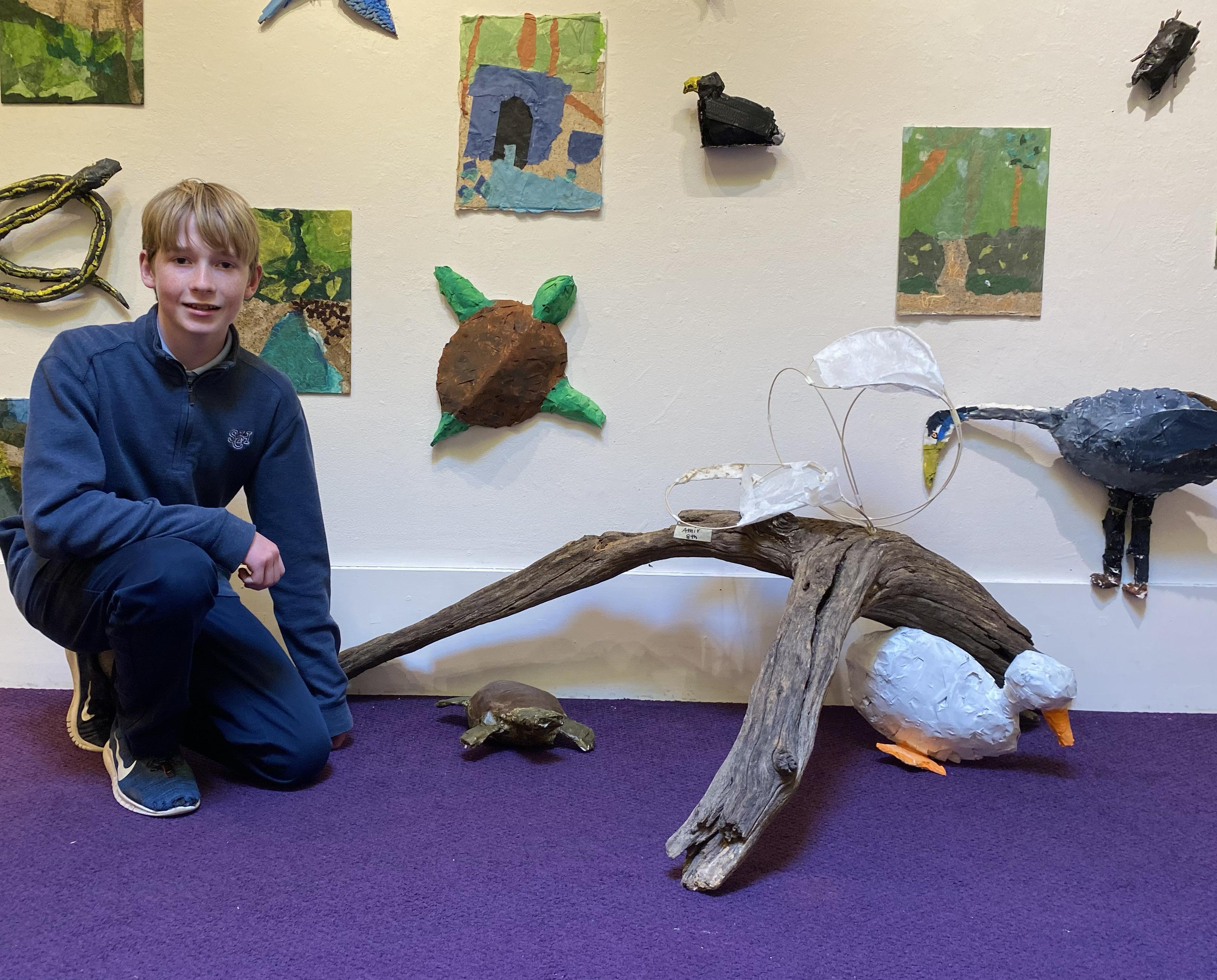
The Visual Arts program at SCH fosters creative thinking while equipping students with the skills needed for personal expression and artistic exploration. Through immersive experiences in a wide range of media, students are encouraged to develop into imaginative and inventive thinkers.
Art Studios emphasize both individual and collaborative projects, with ongoing dialogue and critique as essential tools for artistic growth. This reflective process helps students draw from different facets of their identity as they evolve into confident, accomplished artists. Students learn to engage deeply with the creative process and use ePortfolios to document their progress, reflections, and developing voice.
The Visual Arts program proudly showcases student work throughout the year in the Carpenter Gallery and at the All-School Art Show in the spring.
Drawing Progression
Drawing and painting form a foundational element of the Middle School art program, playing a crucial role in students’ cognitive development. These practices help students think creatively, enhance hand-eye coordination, refine technical skills, and conceptualize ideas. Drawing and painting facilitate students’ creative process, teaching them to observe, describe what they see, and refine their ideas and concepts. As a means of self-expression, whether it be through portraying something accurately, clarifying a thought, such as making a social commentary, or crystallizing an idea, drawing and painting offer a powerful way for students to express their thoughts and perspectives.
Sculpting Progression
Creating three-dimensional art through molding, casting, carving, and construction is key to understanding space and form. Students manipulate materials such as clay, wood, and metal, building technical skills and refining their observational abilities. This
process deepens their understanding of artistic expression and strengthens their ability to conceptualize and bring ideas to life in three-dimensional space.
Connecting Art to the World
SCH’s Barbara Crawford Gallery is a dynamic space that fosters self-discovery through both externally curated exhibitions and student and faculty shows. Each exhibition is thoughtfully selected to inspire conversation and engage the community, complemented by educational programming designed around each one. By utilizing the Crawford Gallery alongside the neighboring Wissahickon and local museums, students gain valuable opportunities to connect their artistic practice to the world around them.
New Media
New media skills are essential for all students since they provide a gateway to digital creation. These skills include creative coding, design and fabrication, interactive technologies, communications, and design. New media courses continue through the CEL Capstone project in 10th-grade. After Capstone, students may elect to pursue larger projects in classes in Creative Coding, Architecture, Digital Design, Fashion Design, and Video Production, as an arts elective in the Upper School. The newly renovated VidCast & Jamie Bell Recording Studio on the Middle School campus feature a production room with green screens, a recording studio, and two teaching spaces with desktop computers running professional-level video and music software.
Music
Music is a powerful form of expression that fosters connection, communication, and collaboration. At SCH, Middle School students engage in choirs, instrumental ensembles, and Music Explorations. Each program is designed to build music literacy, enhance listening skills, and develop fluency in musical expression. Students progress at their own pace and use a digital ePortfolio to reflect on their growth throughout the program. Ensembles perform twice a year, offering opportunities to showcase their skills and creativity. To further enrich their experience, students also learn from visiting guest artists. Recent guests have included singer-songwriter Jon Muq, blues artist Shemekia Copeland, double bassist Xavier Foley, Conjunto Philadelphia, and Grammy Awardwinning composer Dennis Matkosky.
Instrumental Progression
The instrumental music program offers a progressive series of Band and String Orchestra Ensembles, tailored to the skill levels of students in strings, woodwinds, brass, and percussion. Students deepen their musical understanding through the study of theory, composition, and music history. By performing works from diverse genres, styles, and cultures, students enhance their skills and expand their musical horizons. Each ensemble showcases its growth through two major performances each year.
Choral Progression
The Middle School choral program offers students an exciting journey of musical growth, emphasizing collaboration and a wide range of musicianship skills. Through vocal technique, ear training, and sight-singing, students explore and perform everything from unison to multi-part choral works, drawing from diverse styles, genres, and cultures. Boys in grades 5–8 come together to form the Middle School Boys Choir,
while girls perform in dynamic, grade-level ensembles. Both choirs showcase their talent with two performances each year.
Music Explorations Progression
The Music Explorations curriculum at SCH offers a hands-on exploration into the world of music. Students explore the essentials of rhythm, melody, and form while mastering music production and recording techniques. Through creating original compositions and arranging songs with digital audio workstations and looping software, they discover the creative process behind music-making. The curriculum also takes students on a global journey through diverse musical traditions, showing how music reflects the values and cultures of different societies. Their learning comes to life in vibrant world music ensembles, including the Afro-Cuban Percussion Ensemble, West African Drumming Ensemble, Ukulele Ensemble, and groups featuring self-made instruments like the shekere and cajon.
PRIVATE LESSON PROGRAM
The Music program at SCH offers an after-school private lesson program, providing students the opportunity to study with master teachers across a wide range of instruments and voice. Instruction is available in Piano/Keyboard, Strings (Violin, Viola, Cello, Bass), Guitar, Woodwinds (Clarinet, Flute, Saxophone), Percussion, Brass (Trumpet, Trombone), and Voice.
To foster musical growth and build confidence, students are encouraged to take part in performance opportunities throughout the year, ranging from informal studio classes to formal recitals.

SANDS CENTER FOR ENTREPRENEURIAL LEADERSHIP
The Sands Center for Entrepreneurial Leadership (CEL) is committed to developing an entrepreneurial mindset and skillset in every student at SCH. While CEL extends to students Pre-K–12th grade, CEL in Middle School focuses on courses from Digital Storytelling—Audio to Money Matters to Intro to Coding. The CEL program prioritizes the development of four key traits that comprise the entrepreneurial mindset: opportunity seeking, creative problem solving, resiliency, and resourcefulness. These traits are woven throughout students’ CEL curricular experience.
Grade 5
Adventures in New Media
Through character design, pixel art, coding, and controller fabrication, students create original video games that address a change they’d like to see in the world. Students explore the design process through new media technologies and build confidence in their ability as makers.
Teamwork and Collaboration
Teamwork and collaboration hone a variety of skills that will prove valuable to our 5th-graders in all entrepreneurial work at SCH and beyond. Students explore their entrepreneurial identity with a focused study on skills such as creative problem-solving, communication, compromise, time management, and collective effort in both teambuilding challenges as well as larger projects.
Digital Storytelling–Audio
This course is an introduction to voice and sound as a method of self-expression and storytelling, along with the basics of audio recording and editing. As a class, students explore their vocal toolbox, leveraging it as they record an audio drama. Students are also introduced to sound effects and manipulating sound as tools to communicate emotion within a story and hone their ability to bring stories to life through what a listener hears.
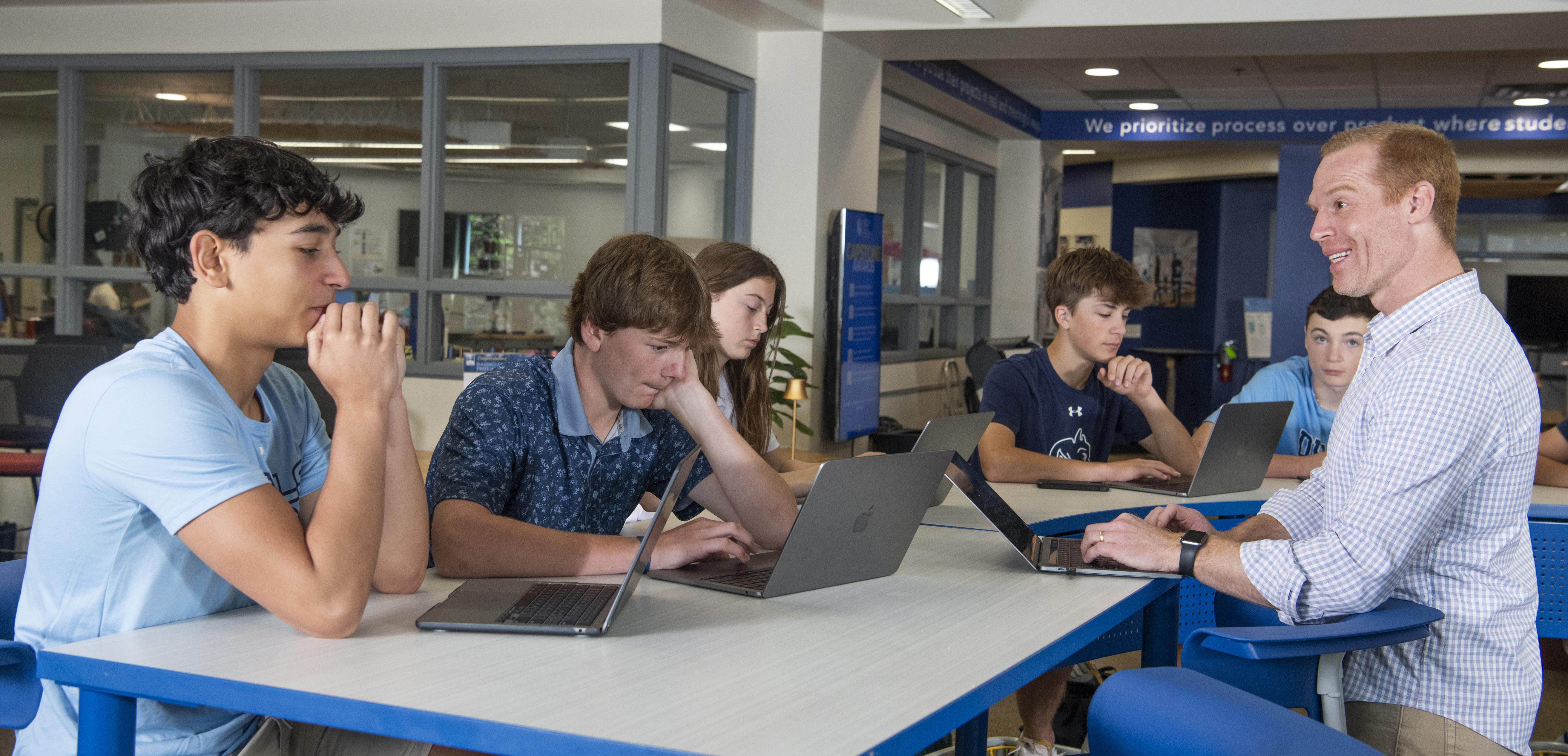
Grade 6
Digital Storytelling–Video
This course introduces students to video production and continues to build on their communication skills as they focus on using visual means to tell stories. Students develop skills in brainstorming, storyboarding, camera usage, and video editing as they create Day-in-the-Life videos, How-Tos, and even narrative pieces.
LEGO Robotics
This course immerses students in the exciting world of robotics. Through collaborative projects, students will apply engineering design skills to tackle challenges at each stage of the design process. Each project presents a unique problem and success criteria, such as climbing a rope to deliver materials at different levels of a “mountain.” Students will create various prototypes, establish systematic testing procedures, and analyze data to refine their solutions. This hands-on approach empowers students to develop innovative thinking, problem-solving abilities, and teamwork skills essential for success in robotics and beyond.
Food Entrepreneurship
Calling all food innovators! We live in a warming world, one with a growing and urbanizing population. How are social entrepreneurs, farmers, and food scientists working to sustainably meet the nutritional needs of all people on our planet? In this class, students embark on a journey to uncover the past, present, and future of food security, while also learning about the everyday decisions that factor into operating a food-related business.
Grade 7
Introduction to Coding
This course is designed to motivate students to learn computer science to improve realworld relationships, connections, and life. Students learn about coding using Python through a variety of engaging activities, including game-based learning in CodeMonkey, hands-on programming exercises, and creative projects such as choose-your-ownadventure games.
Introduction to Engineering and Design
Throughout this class, students use engineering design principles and processes to create sustainable features and infrastructure of a future city. Using tools like computerautomated design (CAD), a 3D printer, laser cutters, and more, students develop research, collaboration, and problem-solving skills to tackle some of the world’s biggest problems.
Media and Presentation
This course serves as a gateway to help students become confident and engaging presenters, through developing their own short TED-style talk, focused on something they consider to be an idea worth expressing. Through these presentations rooted in their passions, students explore and expand their skills in effective communication, slide creation and design, body language, analyzing presentations, and public speaking.
Grade 8
Digital Publishing
Approximately 45 unique voices per trimester come together to express their thoughts, opinions, and ideas in one, cohesive magazine. In 8th-grade Digital Publishing, students collectively ideate, organize, design, and publish a digital magazine. In the process, they learn about the rights and responsibilities of content creators; research and write about topics of interest to them; and flex their design muscles.
Industrial Design
This is a design-forward course that offers students the opportunity to use fabrication technology and processes. Students utilize a wide range of materials to create light fixtures. They enter the cyclical design process to hone their creativity, replication, and innovation skills. Their final light project allows for each student to demonstrate their understanding of 3D modeling, laser cutting, and a passion for making.
Money Matters
In this finance-focused CEL course, students are given the opportunity to dream up, develop, and pitch their own unique business idea. Students also develop their own personal budget, engage in economic simulation challenges, and practice investment and money management strategies.
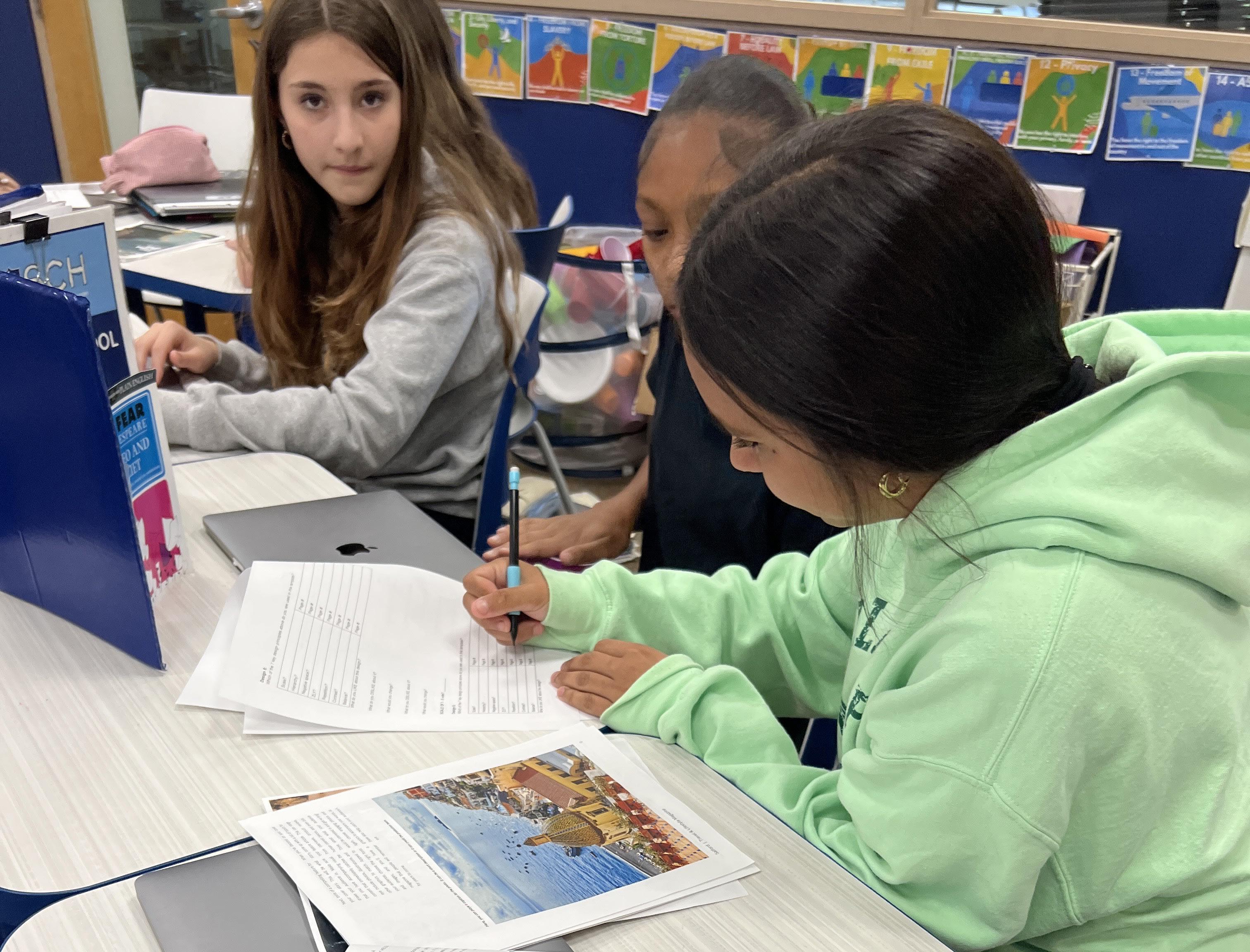
ELECTIVES & AFTER SCHOOL ENRICHMENT
Students have many opportunities to explore their passions in Middle School. Through an elective period, they choose from approximately 15 different activities, ultimately participating in 12 over the course of their Middle School experience. Recent offerings have included Stop-Gap Animation, Student Council, Wallyball, Cooking, Improvisational Theatre, Independent Science Experimentation, Community Service, Student Newspaper, Theatre Technicians, Chess, Hiking, Debate Club, Book Club, Service on Campus, Chinese Calligraphy and Origami, and Drawing from Nature.
Engineering & Robotics
The Engineering and Robotics Department engages students in STEM concepts, handson learning, teamwork, and problem-solving inside and outside the classroom. In the Middle School, the department supports the school’s mission by offering enrichment and competitive teams as part of the FIRST Lego League (FLL) and competitive teams as part of the FIRST Technology Challenge (FTC). Team practices occur after school, and each season has a limited number of competitions occurring around the Greater Philadelphia region on weekends.
Grades 5–6
The FIRST LEGO League engages students in building and programming a LEGO robot. To score points, each team designs a robot to travel along a game board and manipulate different game elements. For example, a game could include an element to free game pieces trapped behind a gate. To solve this problem, teams could design a mechanism for their robot that can lift an arm. Then, they would work then program their robot to drive to the gate and free pieces by using their arm to lift the latch. Primary coding languages are Graphical Blocks and Python. In addition to the physical robot, students must also compete by presenting a research project that focuses on using STEAM to solve problems as part of the season’s theme. The 5th-grade teams focus primarily on enrichment and opt in as a team to the competitions. The 6th-grade teams focus on completing both the robot and the research project. Both teams meet twice a week for two hours during the fall season and may extend into the winter season if they advance during competitions. Sixth-grade students can earn a sports credit for participating in Robotics.
Grades 7—8
The FIRST Tech Challenge (FTC) is an international robotics competition for students in grades 7-12. Each season, students design a robot that is able to manipulate 1-2 specific game pieces and optimize their game strategy to win in a competitive 2-2 match. Guided by adult coaches and mentors, students will gain valuable hands-on skills in Mechanical Design, Programming, Strategy and Data, and Business and Sustainability. In this more competitive game, students deepen their design thinking, growth mindset, and teamwork skills. Student teams must present their robot and design process to a panel of expert judges and can win awards based on their design, programming, business plan, and outreach elements. Student teams are split by grade, and each team has a cap of 10 students. All teams meet twice a week for two hours during the fall and winter seasons. Students can earn a sports credit for participating in robotics.
DRAMA
Grade 5
Formal performing arts education at SCH begins in Middle School with Limelights, our coed drama troupe for 5th-grade students. As the first step in their theatrical journey, the program is designed to ignite a love of storytelling and performance in our youngest Middle School actors. Students build foundational theater skills and collaborate to create and rehearse an original short play inspired by the plot of the production put on by Spotlights, the Middle School theater group. Their performance, which includes brief choreographed dance numbers, is presented on stage alongside the larger Spotlights production.
Grade 6—8
Spotlights is SCH’s Middle School drama program for students in grades 6–8, offering an opportunity to engage in all aspects of a fully staged theatrical production. Students can participate as actors or join the stage crew, with roles in set design, props, costumes, lighting, sound, publicity, and more. Leadership positions such as stage manager or technical director are also available.
Through collaboration, students build a strong foundation in theater, developing skills in scene-building, script analysis, character development, acting techniques, improvisation, and technical design. The program fosters creativity, confidence, and meaningful connections. Past productions include Frozen Jr., James and the Giant Peach, The Wizard of Oz, and Beauty and the Beast.
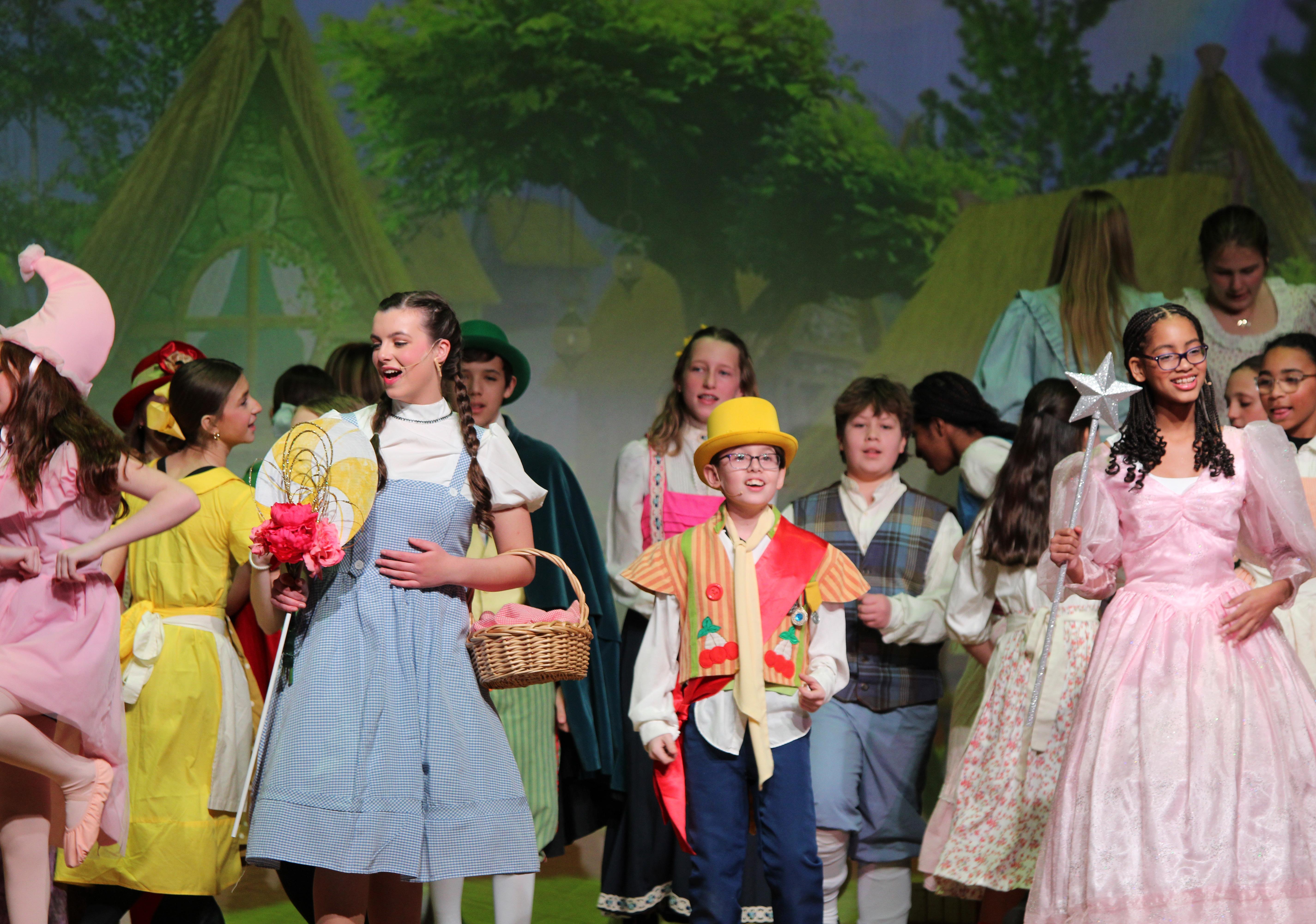
Athletics
Grades 6—8
Athletics are an important part of the overall learning experience at SCH. We embrace, encourage, and teach all that is positive about sport. We stress teamwork, sportsmanship, personal commitment, striving for excellence, and how to win and lose with class and dignity. Knowing that participation in athletics improves students’ self-confidence and overall health, our coaching staff is committed to fostering each student-athlete’s confidence, decision-making skills, sense of responsibility, and leadership skills—qualities that will serve them well throughout life. The department seeks to provide each student with a sense of affiliation, motivation, and accomplishment by balancing challenge and demand with support and encouragement. We hope that, by taking advantage of the many positive experiences that sports have to offer, all participants will enjoy their time on the playing fields and courts and will take with them memories that will last a lifetime. By encouraging broad participation in sports, the Athletic Department also seeks to generate a sense of pride within the student body, the faculty, and the broader school community for its teams and the school.
All students in grades 6-8 are expected to participate in two out of three of the following seasons on an athletic team, or one sport and robotics, or drama.
Athletic offerings, by season:
Fall
Cross Country (B/G)
Field Hockey (G)
Football (B)
Golf (B)
Soccer (B/G)
Tennis (G)
Volleyball (G)
Winter
Basketball (B/G)
Ice Hockey (B/G)
Squash (B/G)
Wrestling (B/G)
Spring
Baseball (B)
Lacrosse (B/G)
Softball (G)
Tennis (B)
Track & Field (B/G)
